LG B5 is a really good OLED TV that shows you don’t need to spend a fortune for very good quality. It offers deep blacks typical of organic panels, very good colour reproduction – especially after calibration – and pleasant HDR movie watching experiences. All of this makes for evening screenings that can deliver cinematic emotions even without reaching for much more expensive screens. The fluidity of the image and the set of features for gamers also deserve recognition. The 120 Hz panel, low input lag, full support for HDMI 2.1, variable refresh rate, and Dolby Vision Gaming mode make the B5 a very versatile screen – great for both gaming and watching sport. The friendly webOS system, along with the Magic remote, provides convenient access to content and makes operation easier. However, not everything is perfect. Compared to the B4 model, there is a slight drop in brightness, especially in very bright rooms. For some users, the lack of DTS audio support may also pose a problem, which could necessitate some workarounds when connecting Blu-ray players. Still, LG B5 remains one of the most sensible choices for those looking to step into the world of true cinema – without overpaying, but also without making major compromises. It’s a screen that doesn’t need to prove anything – it simply delights the eye with great picture quality and works as it should.
- Matching (Score)
- Our verdict
- TV appearance
- Where to buy
- Contrast and black detail
- HDR effect quality
- Factory color reproduction
- Color reproduction after calibration
- Smoothness of tonal transitions
- Image scaling and smoothness of tonal transitions
- Blur and motion smoothness
- Console compatibility and gaming features
- Input lag
- Compatibility with PC
- Viewing angles
- TV efficiency during daytime
- Details about the matrix
- TV features
- Apps
- Playing files from USB
- Sound
LG OLED B5 vs Philips OLED770
Direct compare
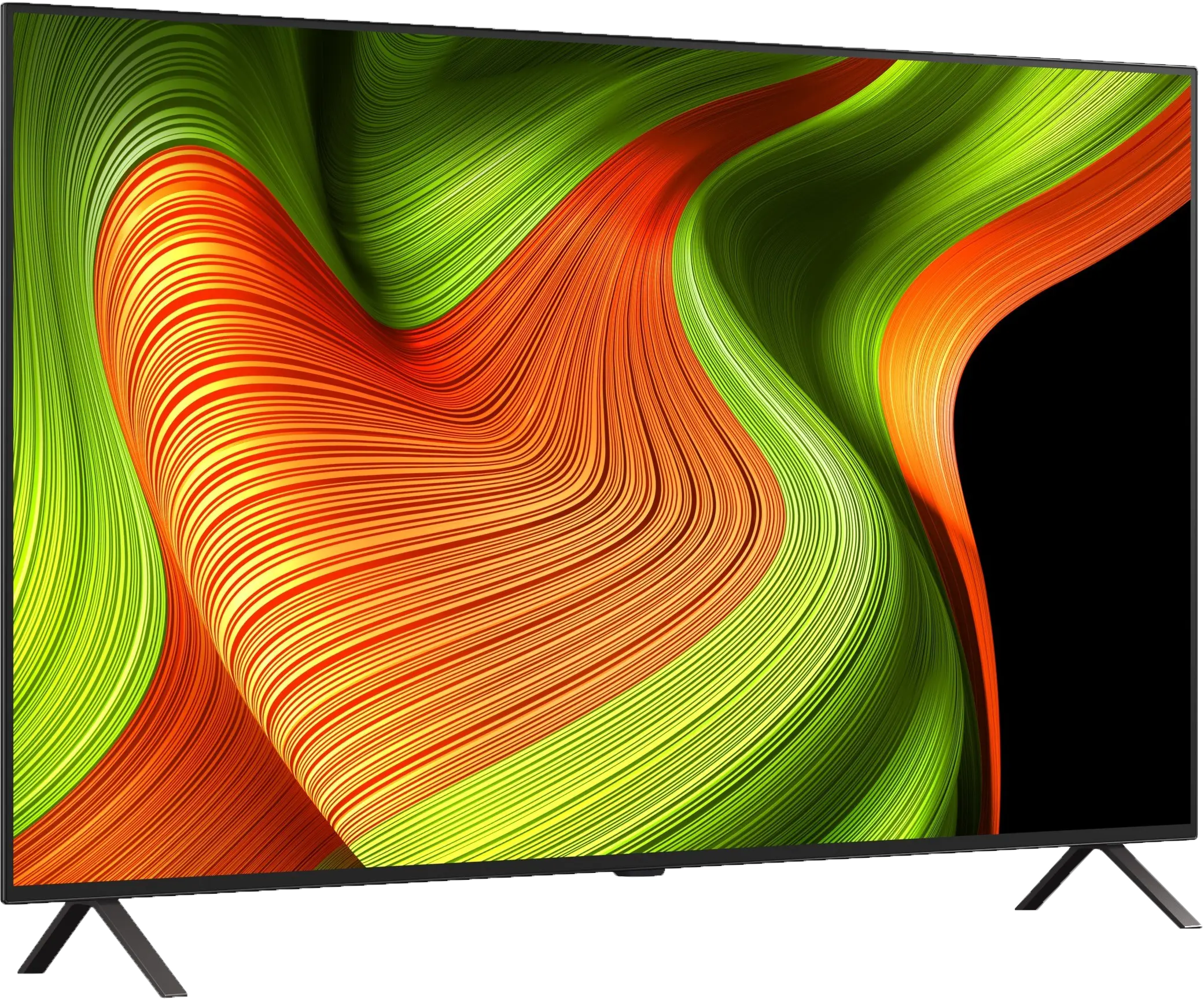

Panel type: WRGB OLED
Resolution: 3840x2160
System: WebOS
Model year: 2025
Complete the survey to find out the result

Panel type: WRGB OLED
Resolution: 3840x2160
System: Titan OS
Model year: 2025
Complete the survey to find out the result

Overall rating
7.8
7.5
Movies and series in UHD quality
7.9
8.0
Classic TV, YouTube
8.6
8.6
Sports broadcasts (TV and apps)
8.5
8.4
Gaming on console
9.2
9.2
TV as a computer monitor
7.6
7.6
Watching in bright light
4.9
4.8
Utility functions
7.9
5.5
Apps
9.1
6.7
Sound quality
7.0
7.0
Complete the survey to find out what fits your preferences
Advantages
Perfect black and contrast
Pleasant HDR image
Excellent colour reproduction capabilities
120Hz OLED panel - great motion smoothness
4 HDMI 2.1 ports and full support for gamers (VRR, ALLM, Dolby Vision Gaming, HGiG)
Very low input lag
Proper content scaling and good digital processing
Convenient webOS system with Magic remote
Built-in USB recording function from the built-in DVB-T/T2 tuners
Excellent image quality typical of OLED – perfect blacks, infinite contrast
AmblightTV system
Support for multiple HDR formats including Dolby Vision and HDR10+
Great image quality after calibration
Decent viewing angles
Excellent motion smoothness – 120Hz OLED panel!
Many features for gamers: VRR, ALLM, Dolby Vision Gaming
Low input lag
4 HDMI 2.1 ports!
Disadvantages
Average brightness and poor performance in bright rooms
No support for DTS formats
Different versions of the remote in derivative models – hard to predict which version we will get
TitanOS has very few apps and has annoying bugs
The remote works on infrared
Not the best upscaling quality
Average reflection suppression – the screen behaves like a slightly dimmed mirror
Our verdict
Philips OLED770 is a television that stands out primarily for its picture quality – the characteristic perfect black and infinite contrast typical of OLEDs make even a regular evening of binge-watching a series feel like a small cinematic experience. After calibration, the colours gain naturalness and consistency, while details in dark scenes are separated from the lights with surgical precision. This is a screen that gives the feeling of engaging with premium-class technology, even though it is formally a budget OLED in Philips' portfolio. The second pillar on which the OLED770 stands very strong is gaming. Here, the manufacturer has really done their homework. VRR works up to 120 Hz, we have an automatic game mode (ALLM), and input lag in standard HDR10 or SDR modes at 120 Hz can drop to as low as 5 ms – these are results that will easily satisfy even the most demanding gamers. And finally, the Ambilight system – for many it’s a gadget, but during longer sessions, it truly makes a difference. The colourful LEDs behind the screen dynamically respond to what's happening in the game, and can pull you deeper into the virtual world. It’s precisely for this reason that one could risk saying that the OLED770 is one of the more interesting budget gaming TVs on the market.
However, not everything shines so brightly, because when we come to the Smart TV aspect… TitanOS is the biggest drawback of this model. Theoretically, we have everything we need: access to apps, AirPlay support, and voice commands. In practice, though, the list of apps is limited, screen mirroring often doesn’t work at all, and voice search does not support the Polish language. Moreover, the remote, although well-designed and backlit – operates on infrared, which sounds almost anachronistic in 2025. The system is purportedly fast, but it can irritate with errors, and instead of encouraging usage, at times, it rather urges us to turn it off. And here we reach the crux: the OLED770 is a television that performs excellently as a screen for movies and games, but not necessarily as a multimedia hub for the home. For someone who mainly uses a console, home cinema, or operator's decoder – it will be a solid choice. We get fantastic picture quality, a full set of modern gaming features, and of course, the proprietary AmbilightTV backlighting system! But if someone is looking for a television that has to replace everything and serve as a multimedia powerhouse, it would be better to look towards the more expensive Philips models that offer more refined system solutions like GoogleTV.
TV appearance
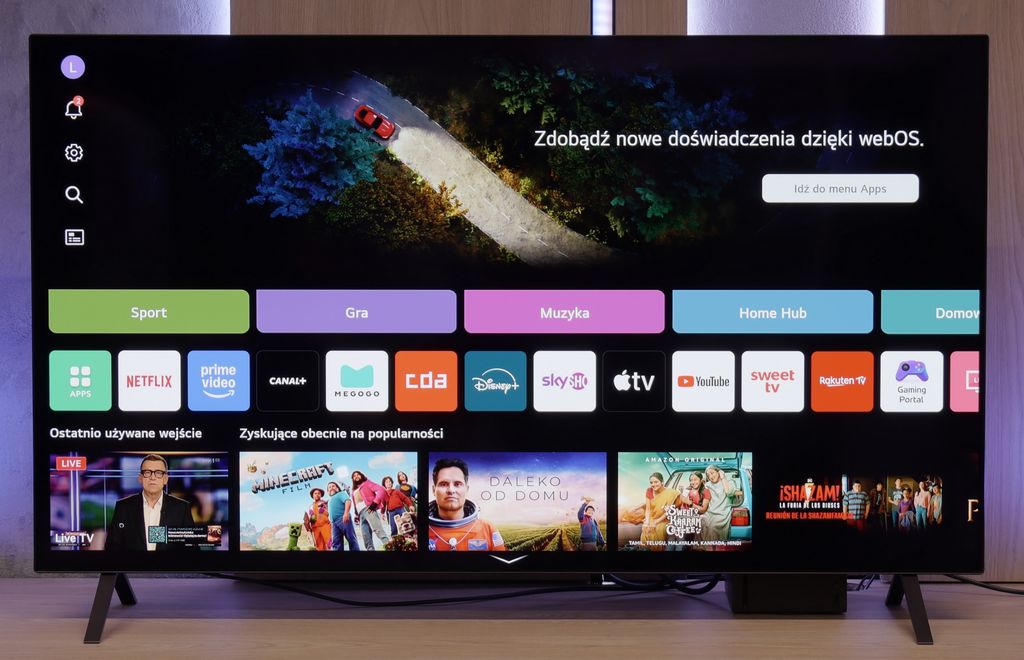
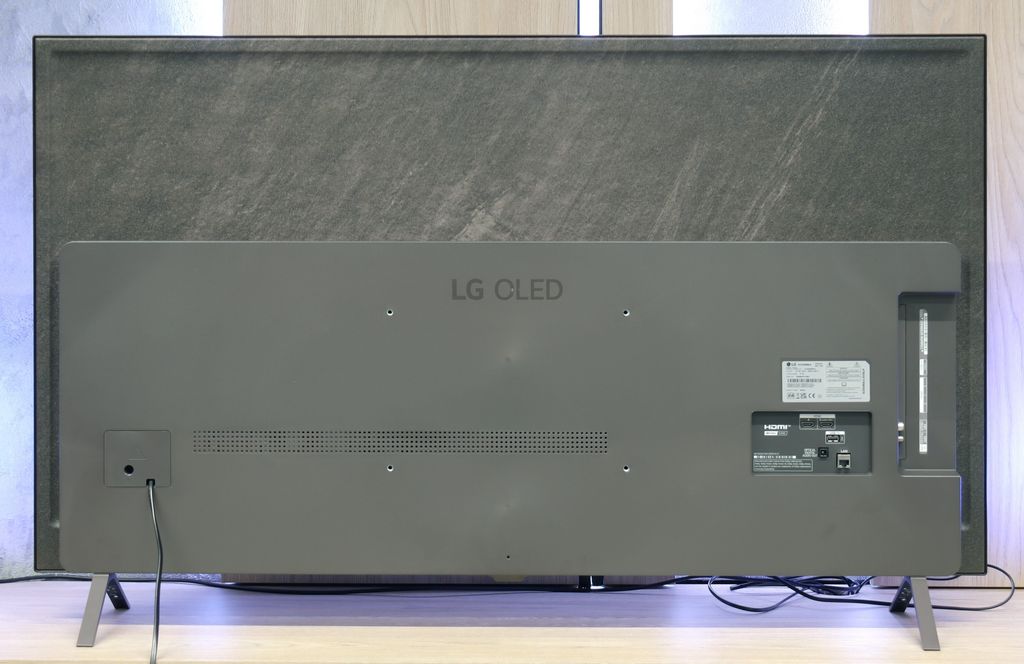
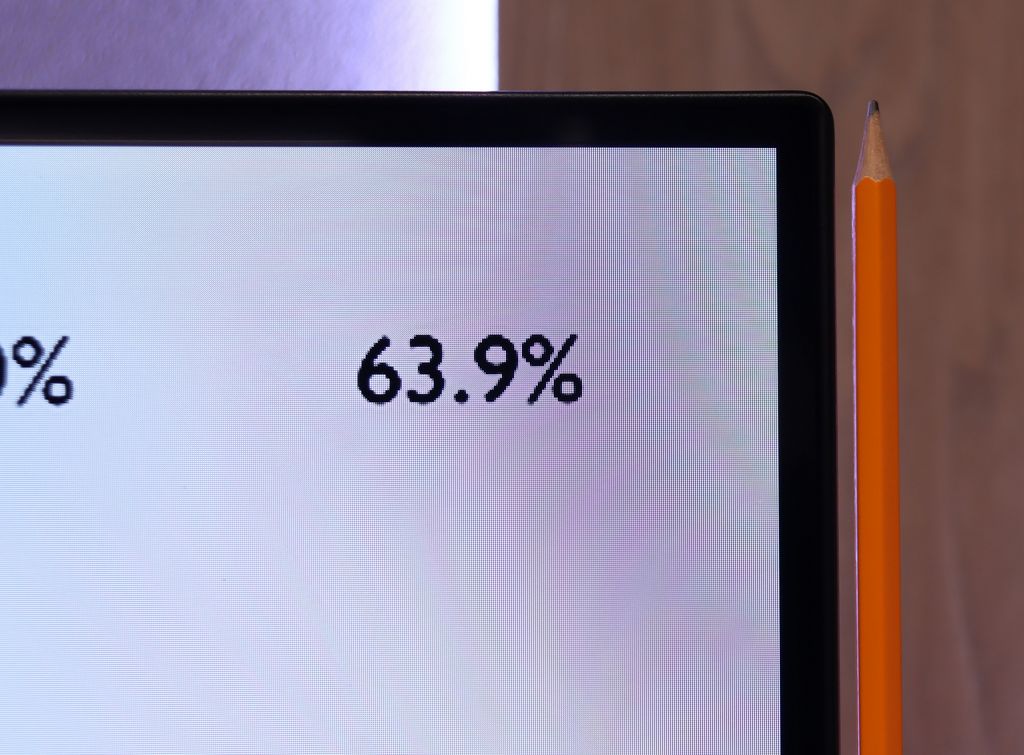




Contrast and black detail
10/10
10/10
Contrast:

Result
∞:1

Result
∞:1

Result
∞:1

Result
∞:1

Result
∞:1

Result
∞:1

Result
∞:1

Result
∞:1

Result
∞:1

Result
∞:1
Halo effect and black detail visibility:
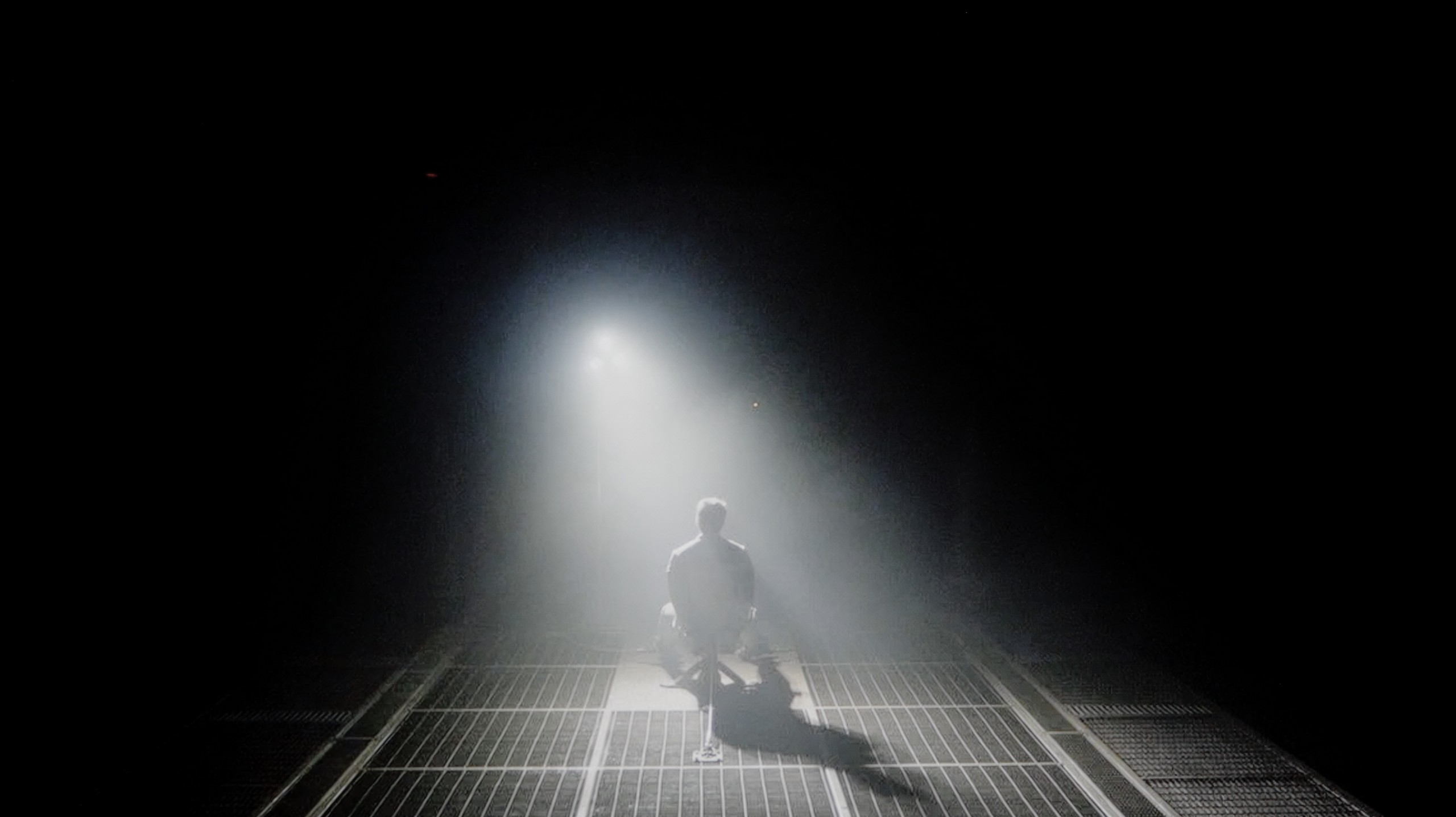

If you're looking for changes compared to last year's LG B4, we’ll clear up any doubts straight away – you won’t find any in this category at all. And that’s a good thing. Because how do you improve something that is already close to perfection? The LG B5, as a WOLED organic panel television, offers black scenes as dark as tar and contrast that’s hard to find even in the most expensive LCD screens. The screen is as clear as a bell – no bleeding, no streaks, no halo effects that can ruin the atmosphere in cinematic scenes. Here, everything is in its place. Details separate from black with surgical precision, nothing blurs together, even in the most demanding sequences from films like The Revenant or Oblivion. This is the type of television that can truly enchant you, especially when the room goes completely dark. When the lights go out, the LG B5 takes centre stage – and it does so wonderfully. In these conditions, OLED shines the brightest, and even top-end LCD models – despite advanced dimming and hundreds of zones – simply fall behind.
In terms of black and contrast, the Philips OLED770 doesn’t introduce any revolutions – but with OLEDs, it would be hard to expect one. The organic matrix allows for complete blacking out of individual pixels, which in practice gives us almost perfect black and contrast that reaches infinity. Whether we’re watching night scenes in films or scenes full of tiny bright points, the TV precisely separates details from the background. There are no halo effects or other artifacts typical for LCD TVs with local dimming here. Choosing an OLED – also in the version of model 770 – you can be assured that in this category, the image will look fantastic.
HDR effect quality
6.2/10
6/10
Luminance measurements in HDR:

Result
587 nit

Result
593 nit

Result
628 nit

Result
589 nit

Result
470 nit

Result
546 nit

Result
657 nit

Result
726 nit

Result
704 nit

Result
275 nit
Scene from the movie “Pan” (about 2800 nits)


Scene from the movie “Billy Lynn” (about 1100 nits)


Static HDR10


Dynamic: Dolby Vision
Dynamic: Dolby Vision


HDR luminance chart:
Philips OLED770
HDR luminance
Luminance of RGB colors
LG OLED B5
HDR luminance
Luminance of RGB colors
LG B5 is a moderately bright OLED TV. Regardless of the scene – it can generate about 500 nits of peak brightness. And interestingly, it does this even in full-screen shots flooded with white, where most OLEDs usually struggle. So, is this screen suitable for HDR films? Yes – absolutely, because such brightness really allows you to feel the magic of HDR effects. However, it’s worth noting that compared to last year's B4 model, the new B5 is darker – by about 100 nits. It may seem like a small amount, but at such average peak values, it makes a significant difference. Fortunately, the TV makes up for it with another strength – excellent coverage of the DCI-P3 and BT.2020 colour gamuts. This means HDR films look truly vibrant, lively, and impressive even in more demanding scenes.
The Philips OLED770 doesn't try to compete with the brightest OLEDs on the market, and it's actually hard to expect that, as it's the entry-level model in Philips' range for 2025. In our measurements, it reached a maximum of around 700 nits, which allows for enjoyment of HDR effects in scenes where light appears in spots – for instance, in the flash of headlights or a starry sky. In such moments, the picture can truly amaze. However, it's different when there are more bright elements on the screen. The TV, like many cheaper OLEDs, restricts luminance at that point, and the entire image noticeably dims. This was best seen in a scene from the movie The Meg, where the sun rises behind an oil platform – the brightness dropped to around 250 nits, which is almost three times less. The HDR effect remains pleasing to the eye, but it's worth being aware that this model performs best in scenes with less intense light. Fortunately, the OLED770 also has an ace up its sleeve – the coverage of the DCI-P3 colour palette is as high as 99%, so colours in movies and games are vibrant and very close to what the creator intended.
Factory color reproduction
8.2/10
6.2/10


Factory Mode
After calibration


Factory Mode
After calibration
B5 was tested in Filmmaker mode and… we’d love to see more TVs like this right out of the box. Seriously. The white balance is very well set – there’s practically nothing to nitpick. Well, if you really want to, you might notice a slight deficiency in blue, which can make the overall picture have a slightly yellowish tint. But that’s just our editorial nitpicking. Most of you probably won’t even notice. We also have minimal reservations about brightness management in HDR format. The EOTF curve – which is responsible for how the TV distributes brightness across the scene – sits just below ideal. In practice, it may happen that the darkest parts of the image appear too dark and simply… disappear. But these are details that only come out in measurements. Generally: we are impressed. But we also know that LG TVs respond very well to professional calibration. You can extract nearly reference-quality picture from them, so – although it’s already very good out of the factory – we took the liberty to go a step further and fine-tune everything to the max.
The first measurements already show that the factory settings of the Philips OLED770 have a lot to improve, even in Filmmaker mode. The white balance chart clearly indicates a lack of blue, giving the image a slightly yellowish tint. In practice, white is not snow-like, but leans towards warmer hues – which some may even find appealing, but from a precision standpoint, this is a deviation from the norm. The gamma, on the other hand, tends to be on the darker side – the average value is around 2.6 instead of the reference 2.4. In mid-tones, the image appears muted and more saturated, which can look too "cinematic" but detracts a bit from the naturalness. However, the most significant issues are visible in colour reproduction. The average error is relatively high, and some colours – particularly shades of grey – deviate significantly from what should be seen. In everyday viewing, this means that sometimes colours may look less natural than we would wish.
Color reproduction after calibration
9.1/10
9/10
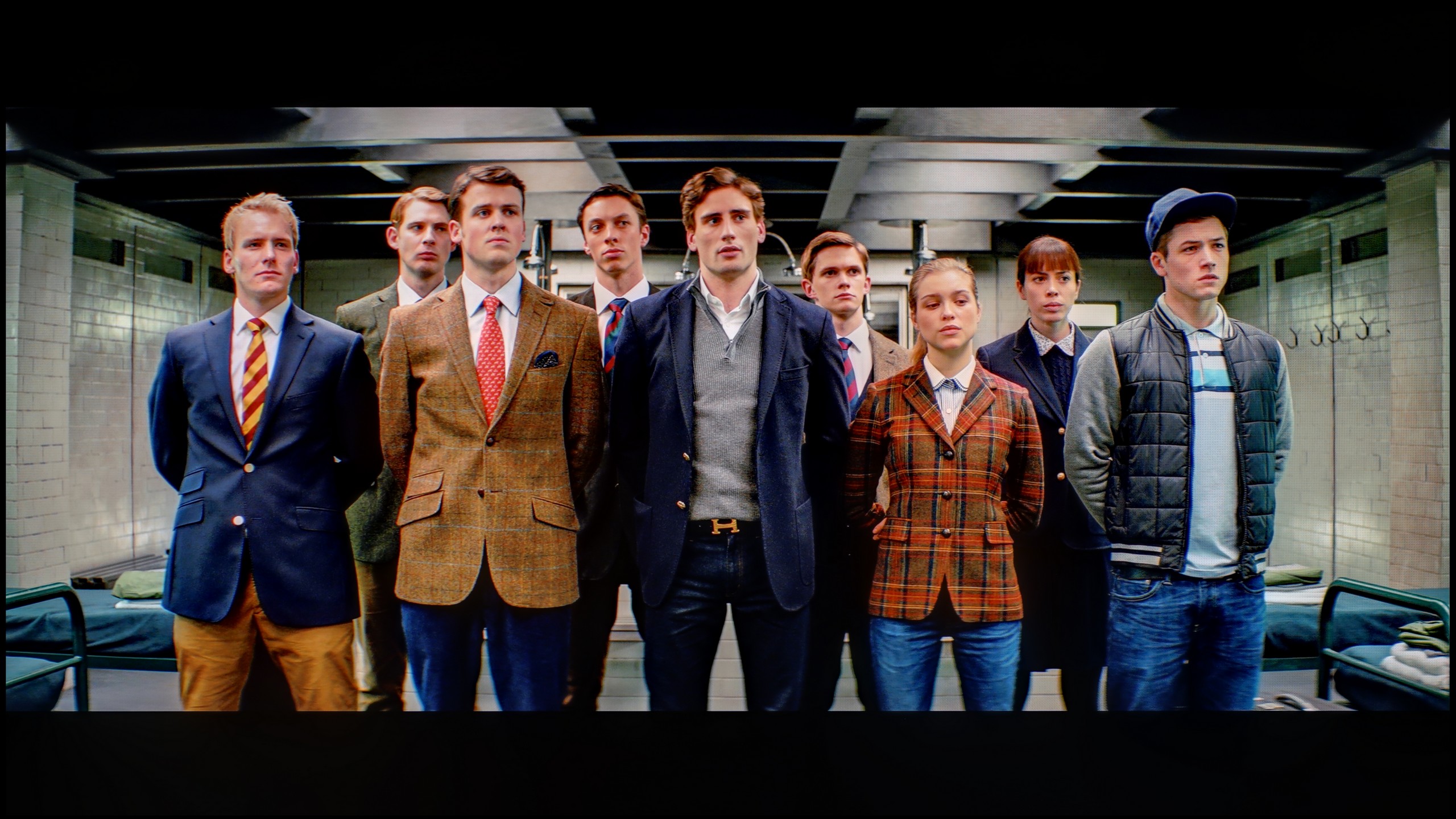

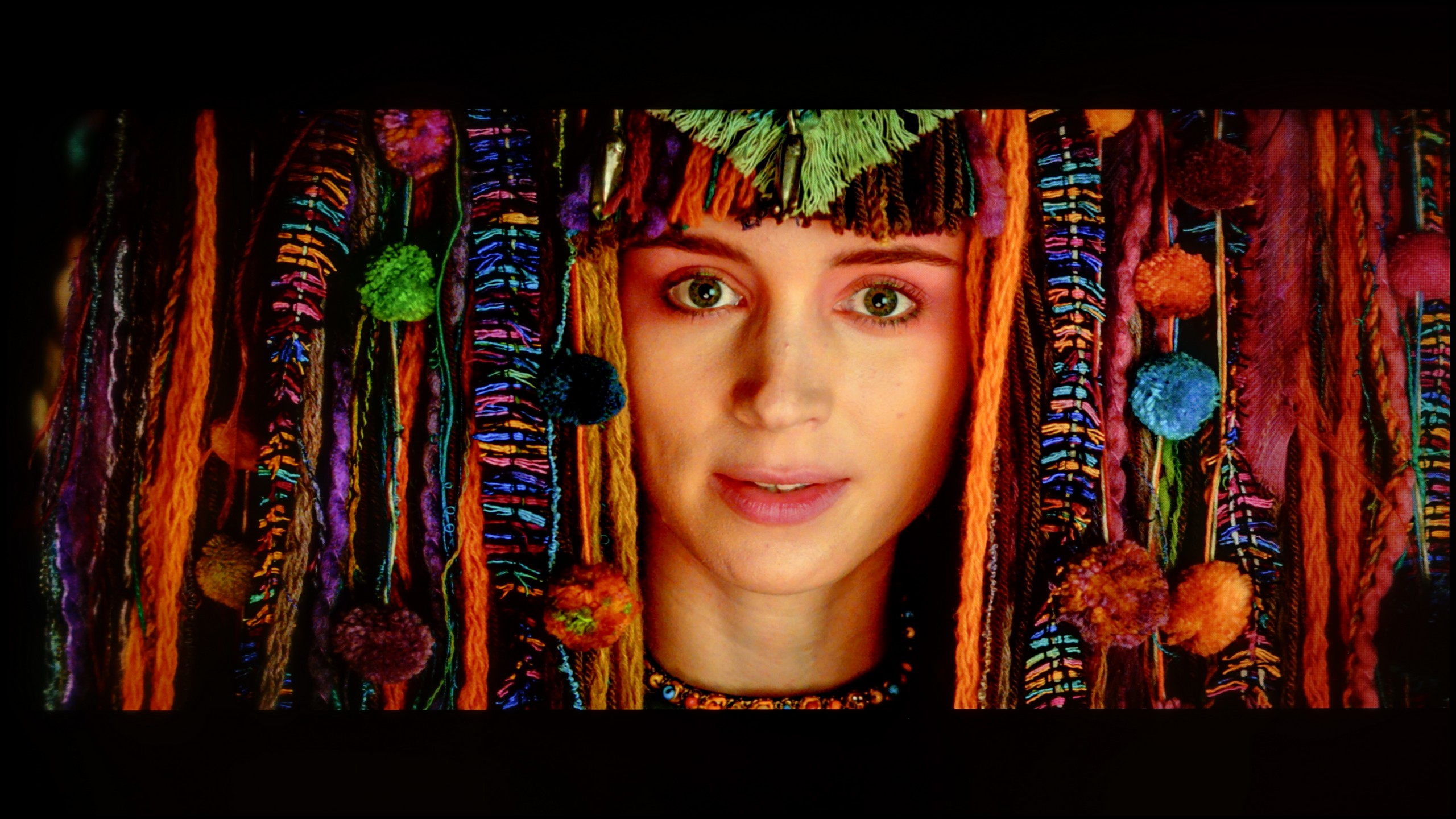

We have to admit that we didn't have much work with the LG B5. It's one of those TVs that look good right from the start, but after calibration… they can really impress. The white balance was nearly perfect – down to a level of errors invisible to the human eye, unless you're a professional colourist with a magnifying glass at the screen. We also managed to control the TV's tendency to slightly dim the darkest details, especially in HDR scenes. After proper tuning, everything looks cohesive: blacks remain deep but don't swallow information. Highlights maintain a natural sparkle, and colours are true to the director's vision. This is truly one of those models that show you don't have to spend a fortune to have an almost reference-quality image. If you can opt for professional calibration – it's definitely worth it for the B5.
Philips OLED770 had shown signs from the start that it harboured significant potential, but it was hard to fully appreciate this in its factory settings. The image was often too warm, and some colours appeared as if they had lost their naturalness along the way. Calibration revealed that this television was very amenable to work – it responded to every adjustment and almost immediately unveiled another layer of its capabilities. The white balance was set in both SDR and HDR so that the yellowish haze disappeared and a neutral, clear white emerged. Gamma stabilised closer to perfection, which helped restore the naturalness of mid-tones, while shadows ceased to be artificially darkened, perhaps even with a slight brightening effect. The result was obvious... Movies are watched with greater ease; the image has cinematic depth without the feeling that something is overly darkened. However, the most interesting aspect was working on the colours. Factory errors were not dramatic, but slightly noticeable – skin tones could be too warm, and grey wasn’t always the shade we expected. After calibration, the error values dropped to around 2, and in many cases even below 1. This is a level that is definitely lower than the threshold of discernibility for the human eye. In other words, after correction, the colours finally “clicked” into place. Looking at the screen, we felt like the television had begun to speak with a full voice. Like an instrument that had finally been properly tuned.
Smoothness of tonal transitions
7.2/10
7.6/10




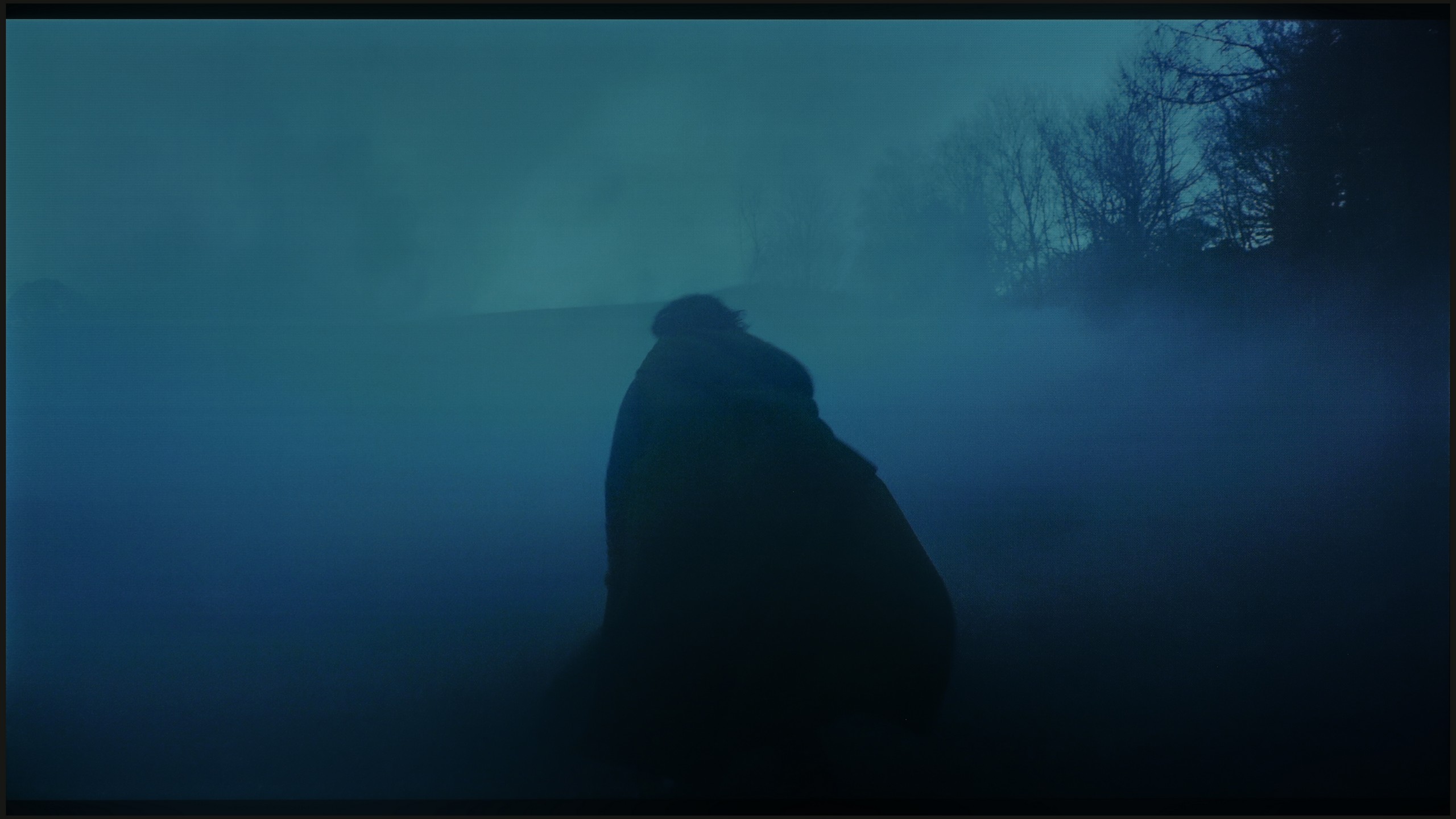

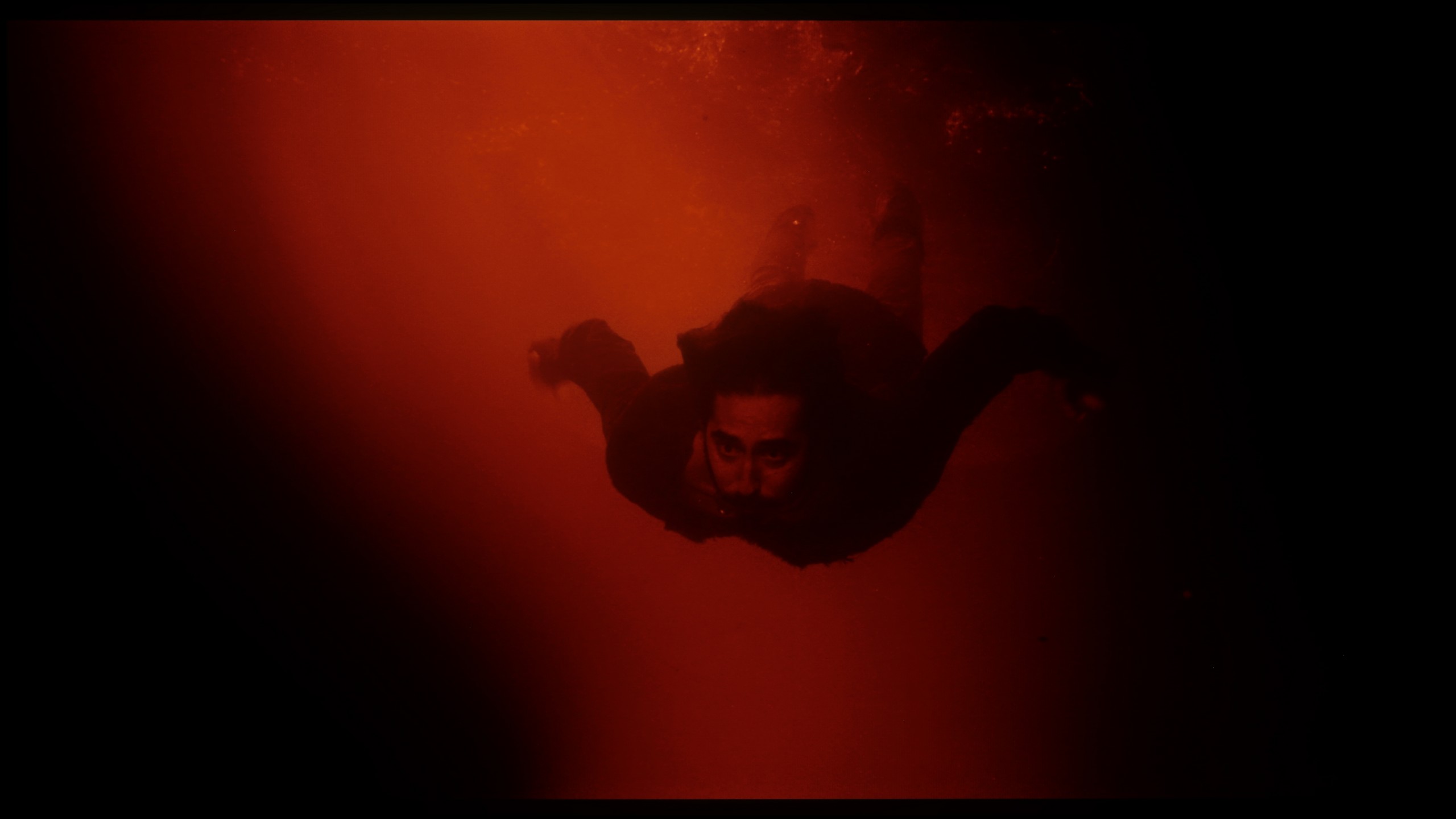





LG B5 handles colour gradation quite decently. In bright scenes, where we have smooth transitions between skin tones, the sky or background, the TV blends colours seamlessly and without hiccups. At first glance – it’s good, particularly considering the price. But just reach for more challenging material – those darker, more demanding scenes with a lot of subtle transitions – and the problems begin. Small artifacts appear, false contours, slight thickening. It’s still not at a level that blinds or distracts from the plot, but the difference compared to more expensive WOLED models – and even more so QD-OLED screens – becomes noticeable.
In this category, there’s a noticeable improvement compared to last year's Philips models. The OLED770 handles colour gradation significantly better, and strongly visible transitions or artificial banding occur less frequently than before. Interestingly, we achieved the best results in dark scenes – where most televisions, especially those with WOLED panels, tend to struggle the most. A good example is the shot of an actor floating in red water – the transition from intense red to black looks nearly perfect here, without the typical “stair steps.” The situation is somewhat worse in light parts of the image. With extremely bright gradients, particularly close to white, the television has trouble maintaining smoothness. This can be noticed, for example, in a scene from the film Kingsman, where in the background of the bright sky with the sun, subtle bands of the sunrise appear instead of a smooth blur. Fortunately, these situations are relatively rare, and in everyday viewing, the OLED770 presents itself very solidly and doesn’t disrupt immersion as was the case in last year's models.
Image scaling and smoothness of tonal transitions
7.5/10
7/10
Smooth transition function
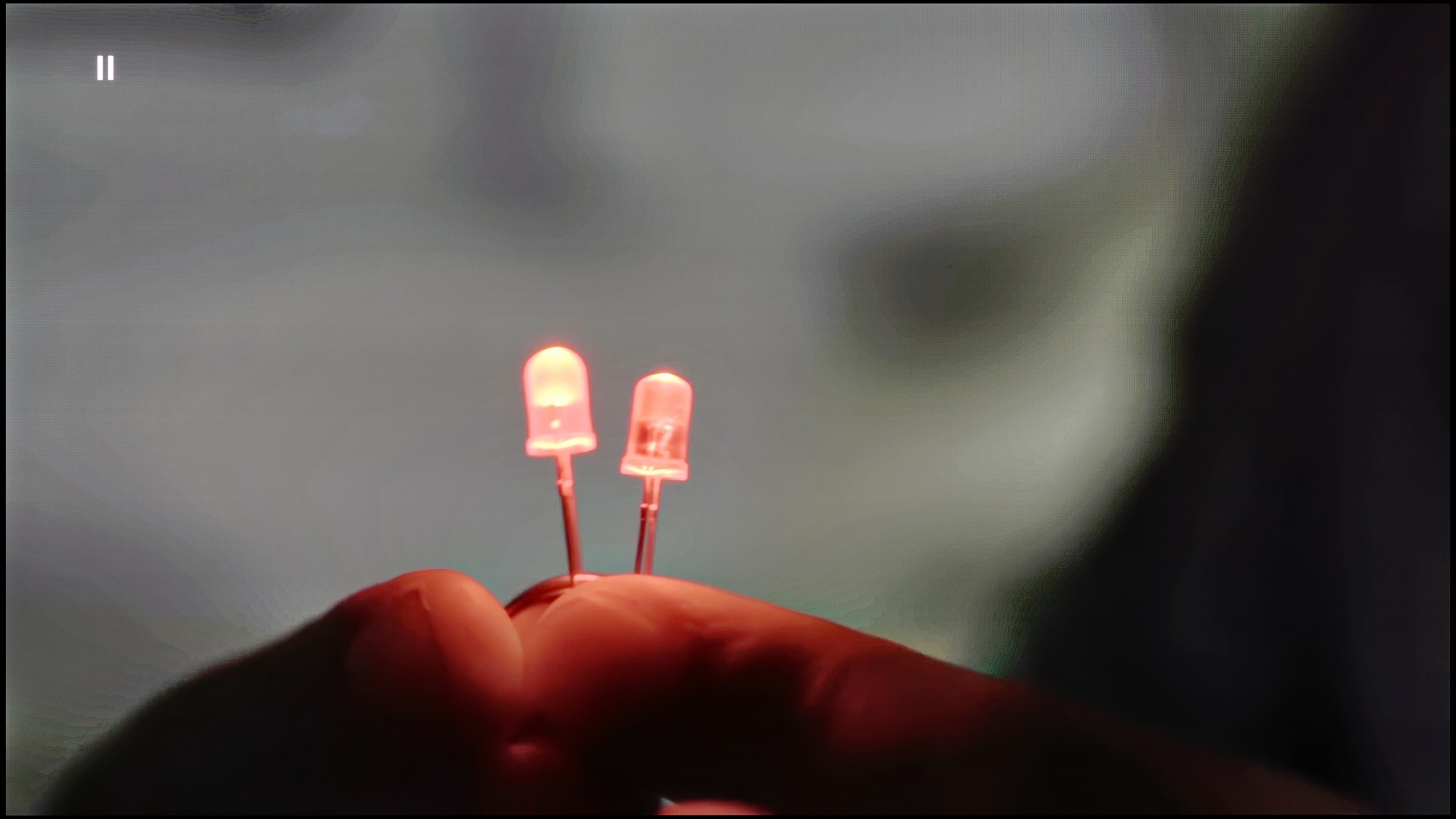

Image without overscan on the SD signal


LG B5 really surprised us positively in terms of handling lower quality content. Thanks to the enhancement and smoothing features, HD or even SD materials come to life. Importantly – when this option is turned on at the "low" or "medium" level, we don’t get the impression that the image is artificially softened or overly smoothed. Details remain in place, film grain doesn’t disappear, and the edges of objects don’t look washed out 😉. It’s a really useful tool – especially if you’re watching free-to-air TV, archival materials, or content from YouTube in lower resolutions. The picture is clear, consistent, and simply pleasant to the eye.
Upgrading as such works very well – even low-quality content is reproduced with surprising fidelity. Unfortunately, it’s not without a minor hiccup. Although the menu has an option to turn off overscan, the television still has issues correctly displaying very low-resolution images. It’s a minor detail, but when watching older materials – it can be annoying.
The problem of the previously mentioned colour connections can largely be mitigated thanks to the "distortion reduction" function, which is an algorithm for smoothing tonal transitions in Philips. It works best at a low level – effectively eliminating unwanted colour bands while not introducing strange artifacts or losing image detail. This is one of those features that is truly worth keeping on.
The issue of upscaling is somewhat less impressive. Images from lower resolution can be too soft, while in some parts the characteristic "jaggies" appear. The impression is that the algorithm is trying to reconcile two contradictory directions – smoothing and sharpening – and ultimately fails to find the golden mean. As a consolation, it's worth noting that the television does not have problems with overscan, meaning it does not cut off the edges of the image, which can sometimes happen in other competing models.
Blur and motion smoothness
8.5/10
8.4/10
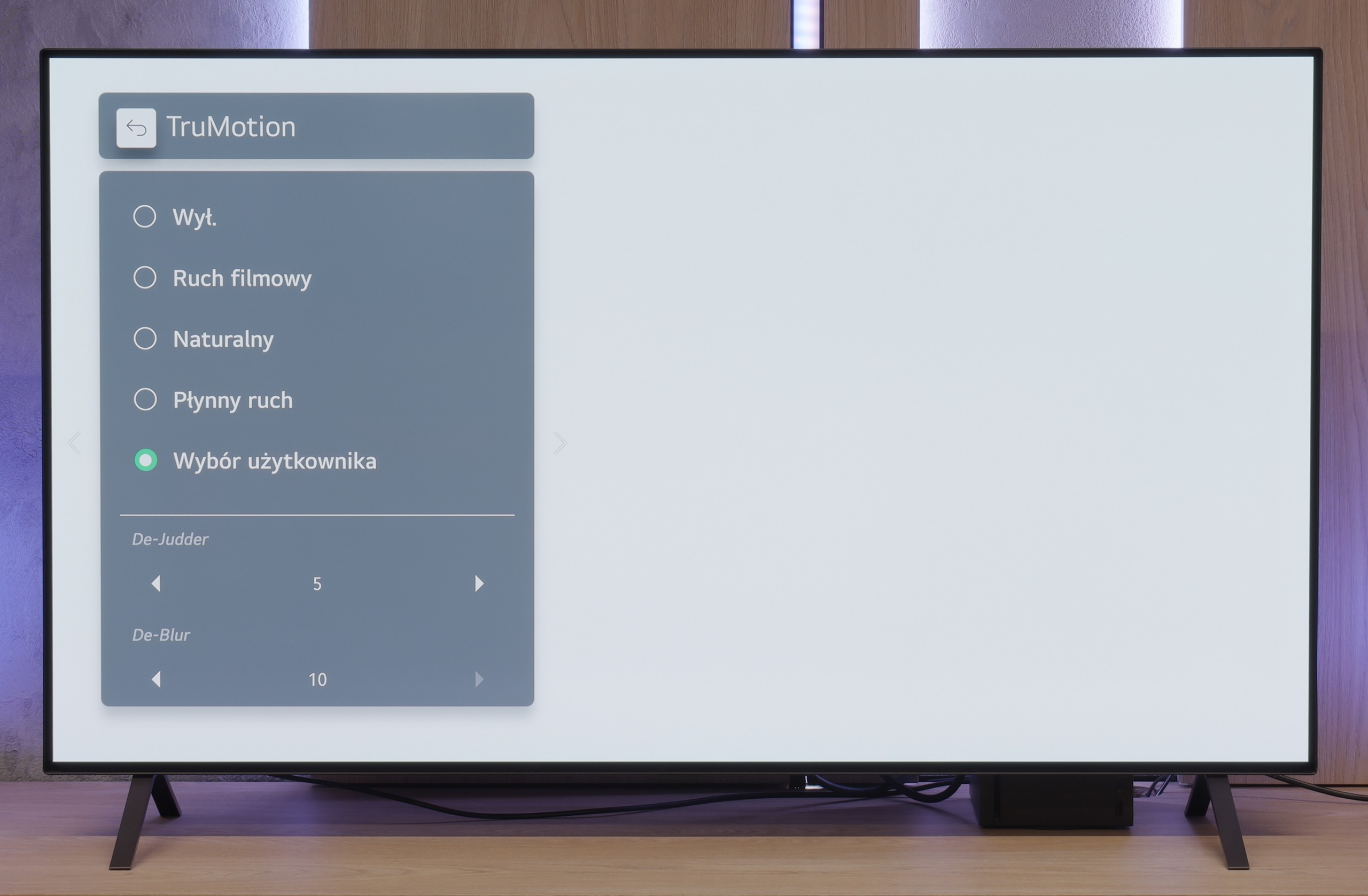

Blur (native resolution, maximum refresh rate):
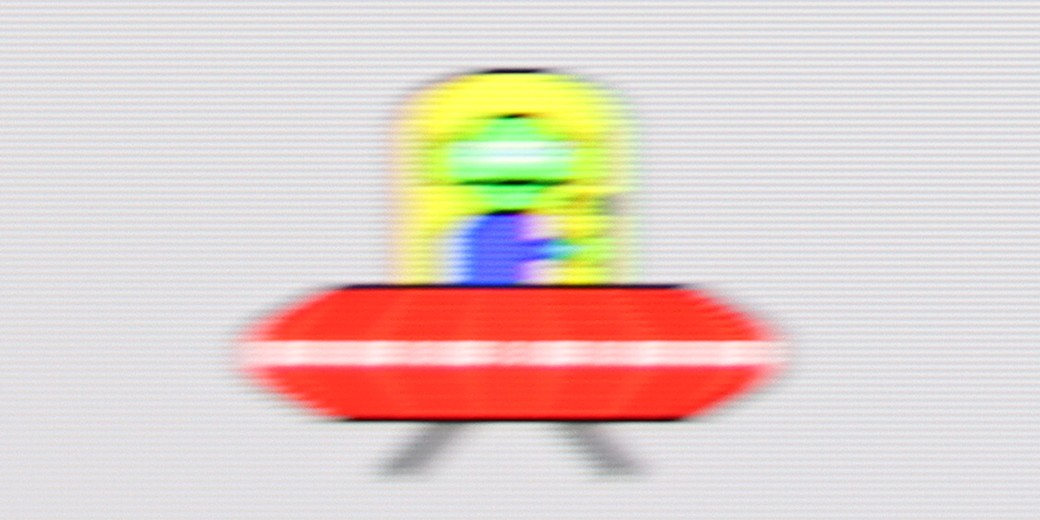
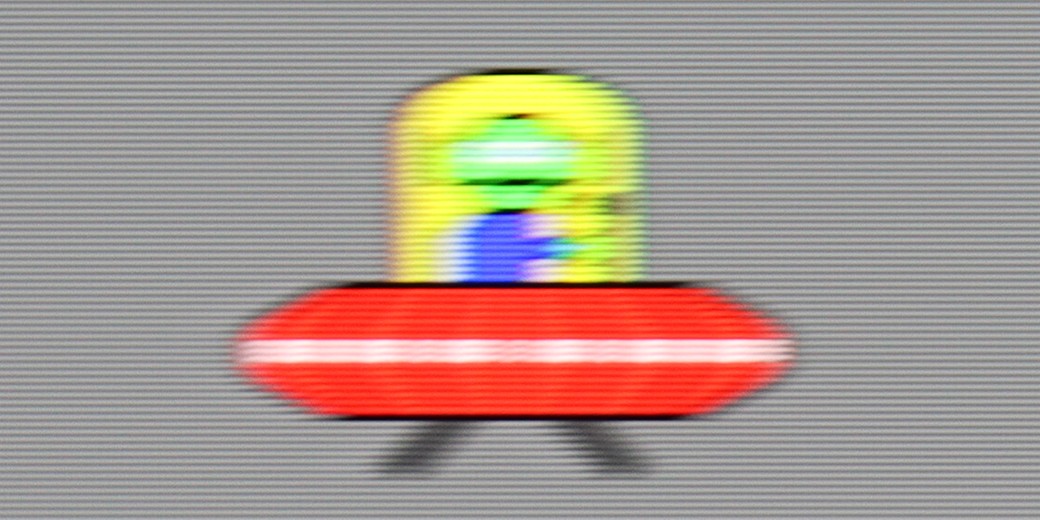
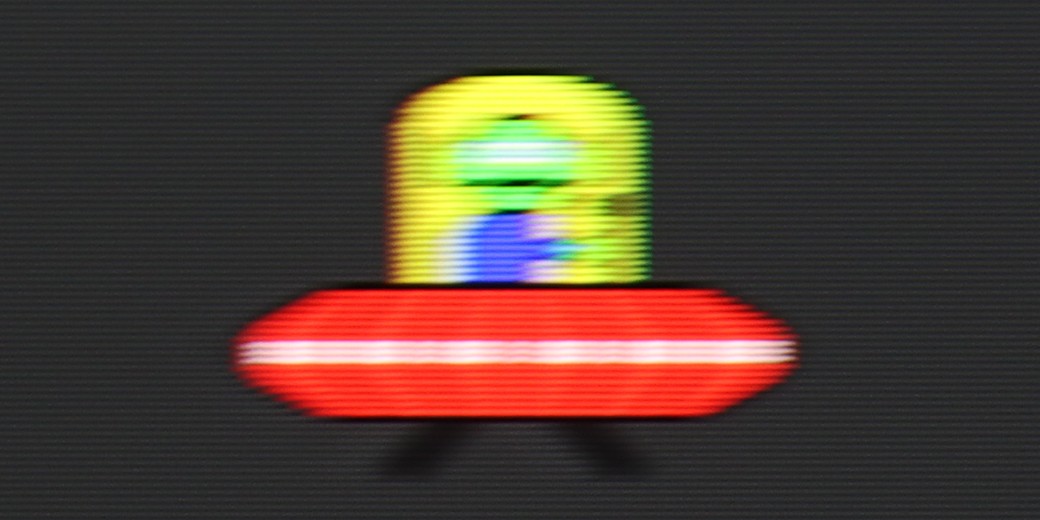



Smużenie ():
Smużenie (4K@144Hz):



LG B5 is a TV with a 120 Hz OLED panel. It may not sound as impressive as the marketing terms "144 Hz" or "165 Hz" commonly found in gaming monitors, but honestly? The smoothness is still excellent. The picture is sharp, fluid, and simply enjoyable to watch – even when there’s a lot happening on screen. The organic panel does its job – the pixel response time is almost instantaneous, which means there’s no risk of ghosting or blurring that can ruin dynamic shots. Sports, fast-paced games – everything looks clear and distinct.
We also have the classic LG motion smoother, TruMotion. It allows you to smooth out movies shot at 24 frames – in other words, most of what you watch on Netflix or from Blu-ray discs. If you set lower values on the “De-Judder” slider, you’ll get a picture closer to the cinematic experience – with a slight judder, but without artificiality. Higher settings? Soap opera effect guaranteed. Fortunately, LG gives you the choice, and you can tune everything to your liking.
The issue of the panel in the Philips OLED770 is not entirely straightforward. The manufacturer claims a 120 Hz panel, but our measurements showed that the screen can accept a 4K signal even at 144 Hz. This sounds like great news – because who wouldn't want an additional mode for PC gamers at this price? However, the reality turned out to be more complex. With 120 Hz content, the television behaves like most OLEDs – the image is absolutely clear, with no trace of blurring or smearing, ideal for both dynamic games and sports broadcasts. The problem only arises at 144 Hz. Unlike models with official support for this frequency, here we see the phenomenon of so-called frame skipping. This means that the television is unable to display all the frames – some of them are skipped, causing motion to lose smoothness and double outlines to appear on the screen. The effect resembles the operation of the BFI function, which Philips does not offer in this model anyway.
Console compatibility and gaming features
10/10
10/10
- ALLM
- VRR
- VRR range40 - 120Hz40 - 120Hz
- Dolby Vision Game Mode
- Correct implementation of HGIG
- 1080p@120Hz
- 1440p@120Hz
- 4K@120Hz
- Game bar
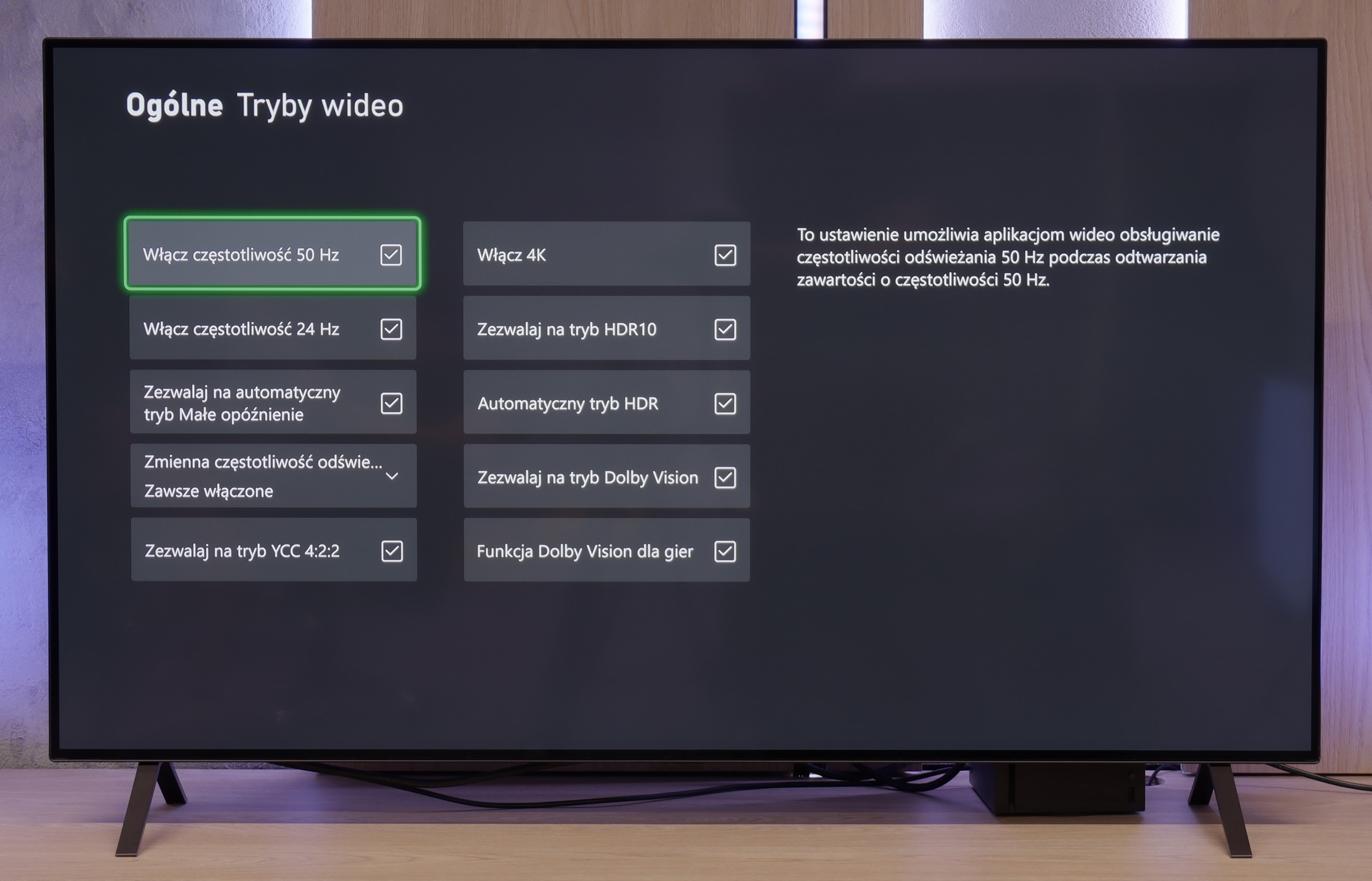

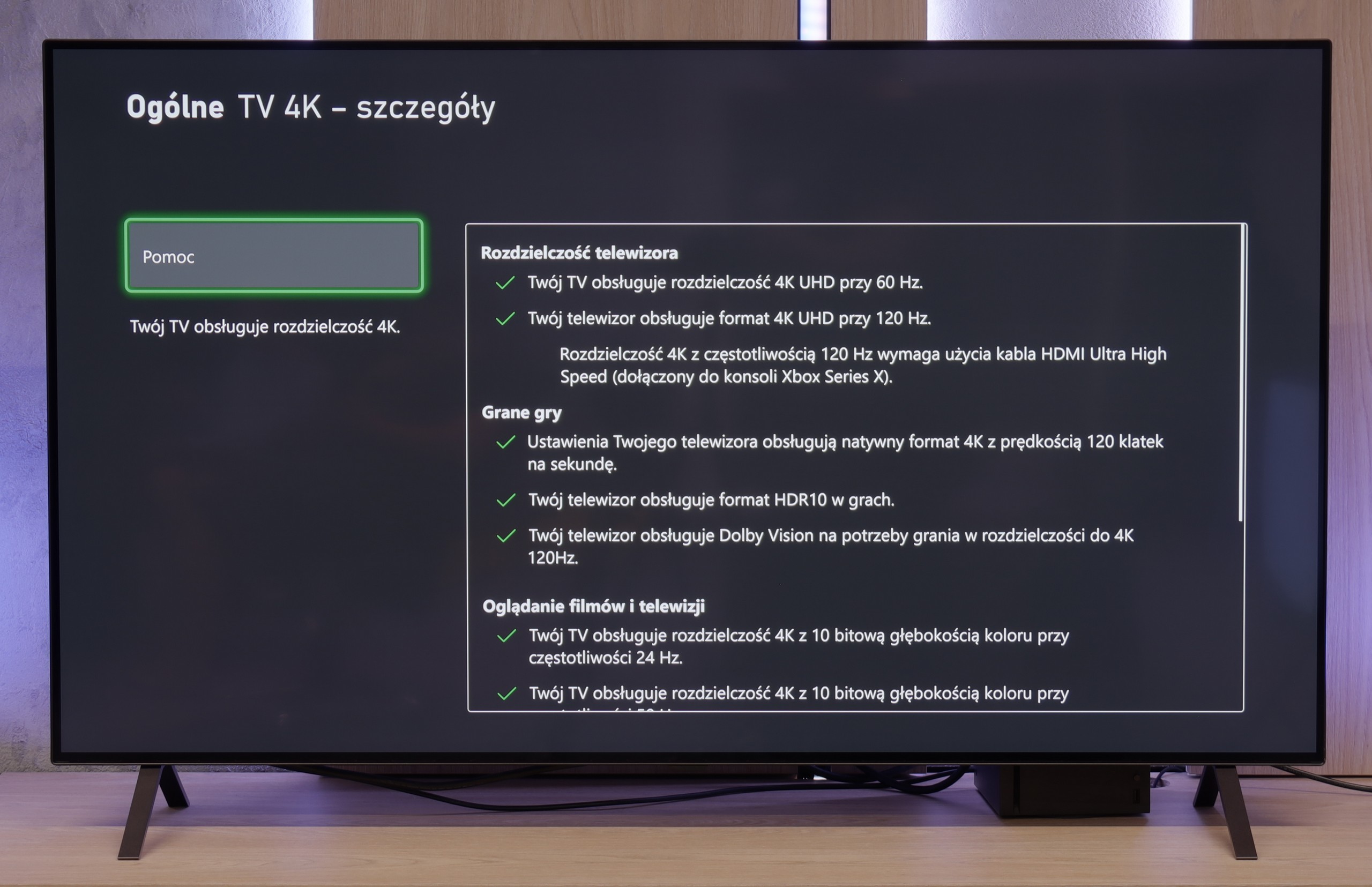

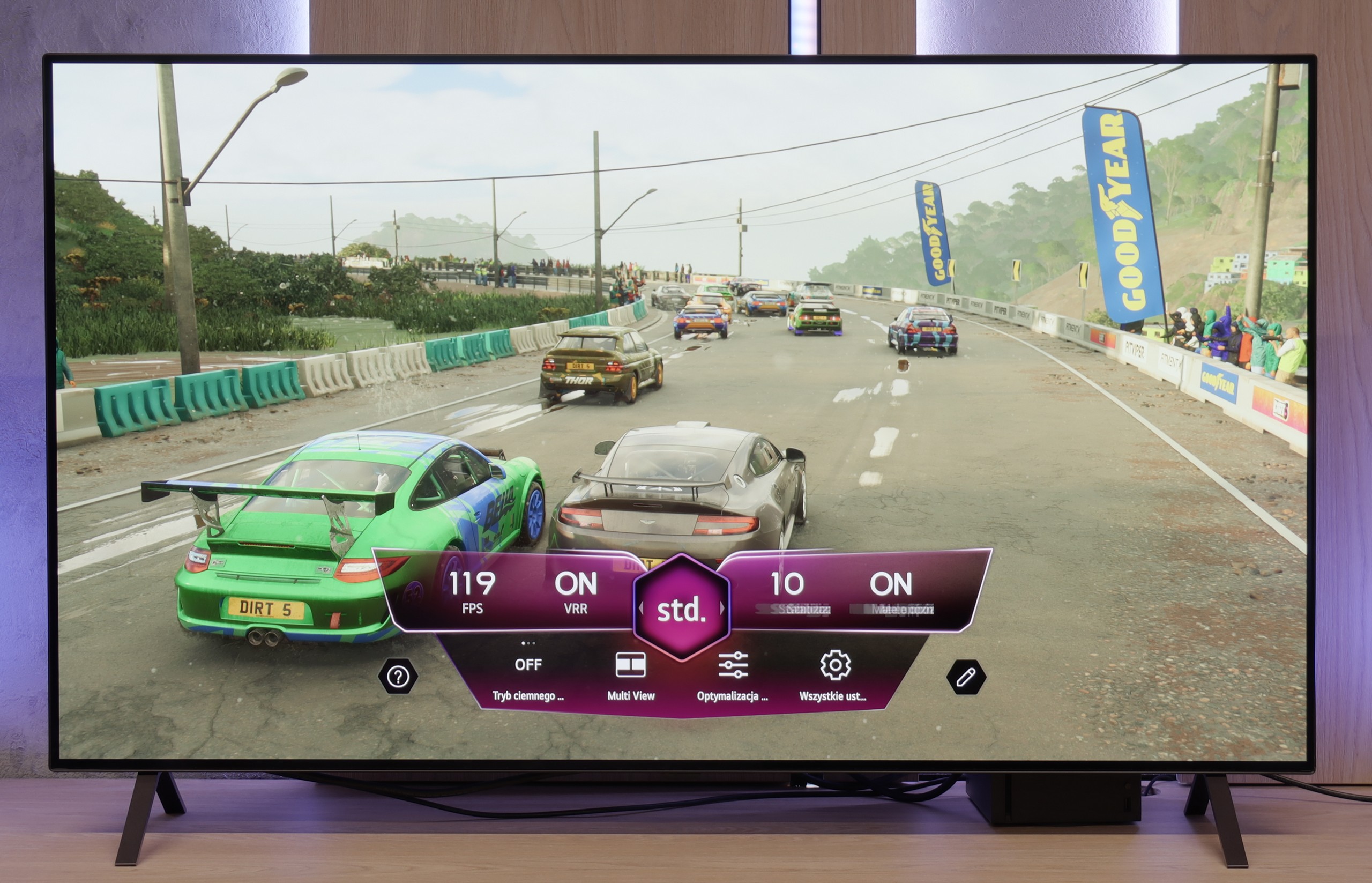

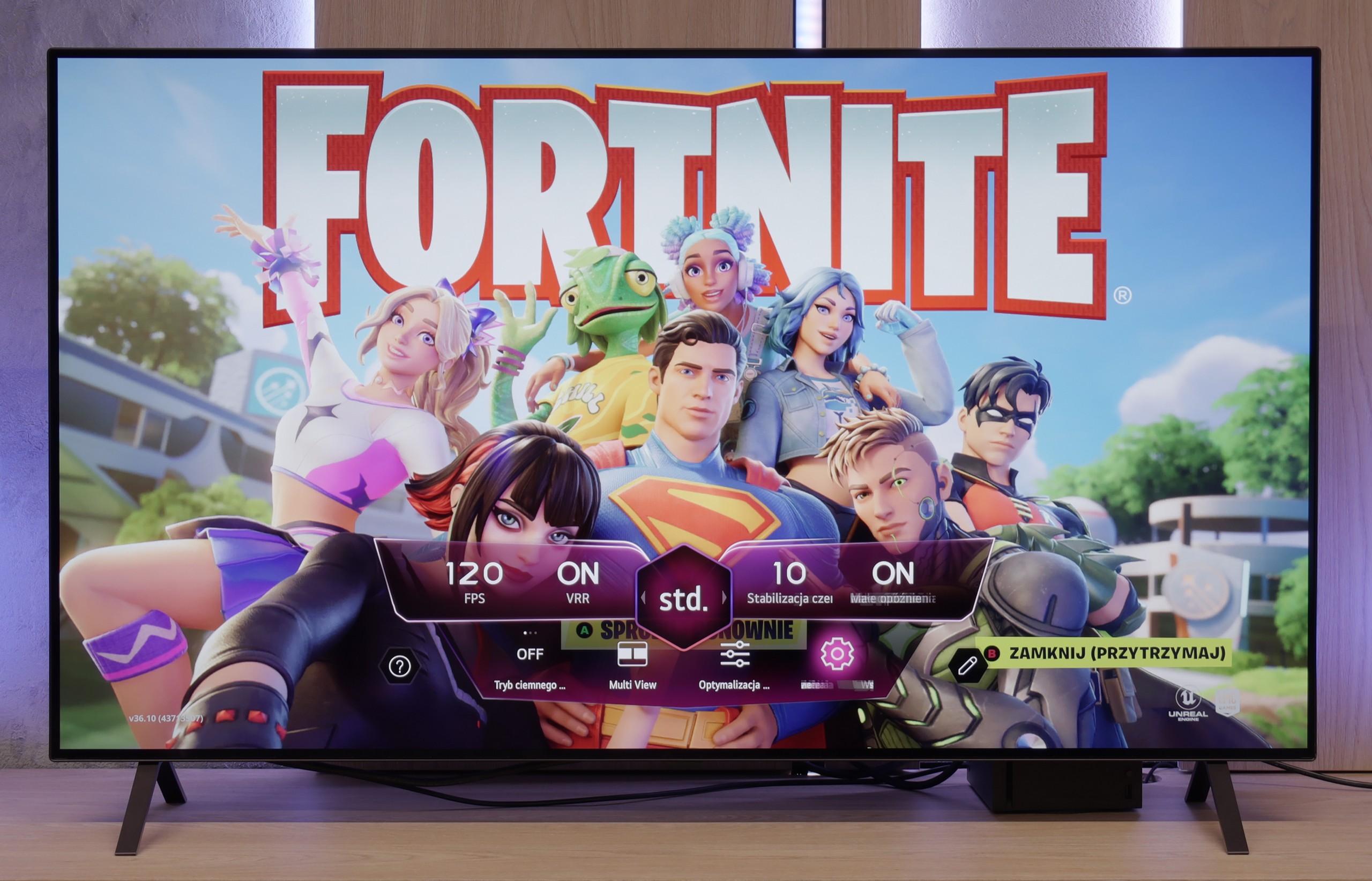

There are already a few TVs on the market with the "for gamers" label that don't really understand what that means. The LG B5 is not one of them. Everything here is spot on – there are four HDMI 2.1 ports, 120 Hz, there’s VRR and ALLM, and there’s also a Game Bar that's actually useful, not just looking good in the brochure. You plug in a console – it works. You set it to 4K at 120 Hz – it works. You have an Xbox and want to play in Dolby Vision – it works too. And it's not just "theoretically supports," it actually turns on, looks good, and you don't have to fiddle with settings for half an hour. Plus, there’s the HGiG picture mode, which LG has implemented correctly – meaning HDR in games doesn't turn the screen into a strobe light, but shows exactly what it should. There are no surprises, no strange limitations, no "buts." And you know what? That's how it should be. Cheers to the LG B5!
If someone is looking for a TV for gaming, the Philips OLED770 is a candidate that's hard to overlook. The mere fact that this is an OLED gives it a great starting point – perfect blacks and infinite contrast make evening sessions in atmospheric games look like they've been taken straight out of a cinema. Added to that is the Ambilight system, which uses LEDs on the back of the TV to extend the image onto the wall behind the screen. The effect is such that even just playing FIFA can look like a small spectacle, and in horror games, the atmosphere becomes really thick. On the technical side, it's also quite decent. The Philips OLED770 supports variable refresh rate (VRR) up to 120 Hz, has an automatic mode for gamers (ALLM), and for those using an Xbox Series X, Dolby Vision support in games is also available. You just need to know that in this mode, the input lag is slightly higher than standard, although still at an acceptable level. As a bonus, we also get the 'Game Bar', which is a special tool strip for gamers. It's not the most conveniently designed solution, but it allows for a quick view of key parameters without exiting the game. Overall, this gives a picture of a TV that has all the most important gaming features on one hand, and on the other can add something unique – Ambilight. And it's this mix of technology and visual effect that makes the OLED770 one of the better screens for gaming in a home environment.
Input lag
9.9/10
9.8/10
SDR
HDR
Dolby Vision
Here we won’t be going on about it – the LG B5 simply has great input lag. For 60 Hz content, it achieves results below 10 ms, and for 120 Hz it even drops to around 5 ms. These are values that can’t be reasonably criticized. It just works instantly, without delays, without surprises. Well... almost. Because as usual, there’s a slight asterisk with the Dolby Vision Gaming mode. In this mode, the response time slightly increases. It's nothing dramatic – they’re still very low values, likely unnoticeable while gaming – but if you’re only playing tournament titles and fighting for every millisecond on your XBOX, it’s worth keeping in mind.
As we mentioned earlier, the only anomaly that has been captured during testing is the Dolby Vision Gaming mode. In this setting, the latency can reach up to 30 ms. This is not a particularly impressive result, and more demanding players may turn up their noses, but in practice – during casual sessions – the difference will not be greatly noticeable. The standard HDR10 and SDR modes perform much better, however. In the case of a 120 Hz signal, the input lag drops to a minimal 5 ms, which is an outstanding result and places the OLED770 among the top TVs suitable for dynamic gaming. In other words, if someone isn’t set on Dolby Vision on Xbox, the gaming experience will be fast, smooth, and free of unnecessary delays!
Compatibility with PC
7.6/10
7.6/10
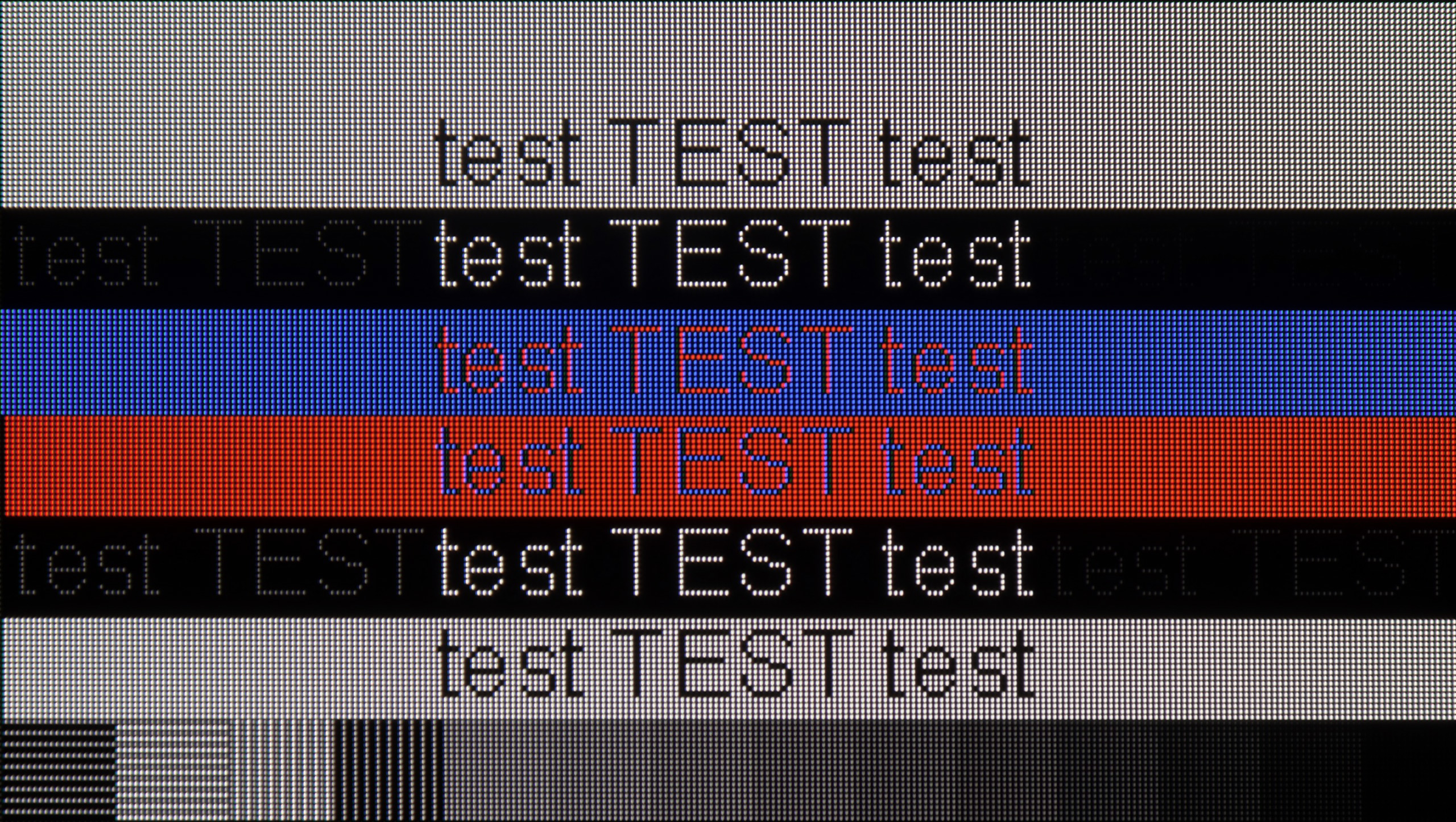

LG B5 is a television that communicates well with a computer. You won't find gaming features like 144 or 165 Hz here, but is that really necessary for anyone? Thanks to the 120 Hz panel, low input lag, and G-Sync support, it's actually a very good screen for gaming on PC. No stuttering, no tearing, with instant response.
But it's not just for gaming. The B5 can also be quite comfortable for... simply working. The television correctly supports chroma 4:4:4, so fonts are legible, interfaces are clear, and your eyes won't hurt from blurry text. This isn't obvious, even among more expensive models. However, there is one "but" – and this applies not only to the B5, but to every OLED with a WOLED panel. The RWGB subpixel arrangement can cause a slight shadow at the edges of fonts. This isn't something that stands out from the couch. It's more likely to be noticed by someone sitting close to the screen and spending half a day in Excel.
Philips has learned from previous models and has finally improved the implementation of chroma 4:4:4. This is important news for those planning to connect the TV to a computer, as it means no problems with sharpness and readability of fonts. Text looks clear and crisp, so the OLED770 can easily be called an excellent display for office work or browsing the internet. Of course, very demanding users may notice some imperfections resulting from the WRGB pixel arrangement typical of WOLED panels, but in practice, this does not significantly impact comfort. The TV also performs well in games launched from a PC. The panel allows for real refresh rates of up to 120 Hz, and with low input lag, this provides a very smooth image without noticeable stutters. The only thing missing is support for G-Sync and – as we mentioned before – a proper 144 Hz mode, but despite that, the overall performance is really solid. For those looking for a versatile screen for computer and console use, the OLED770 is a choice that’s hard to underestimate.
Viewing angles
7.4/10
7.7/10
In terms of viewing angles, the LG B5 performs very well – exactly as you would expect from a WOLED panel. No matter from which side you sit, the picture retains its quality. Colours don't fade, contrast doesn't drop off sharply, and details remain clearly visible. However, it must be honestly added that this is not the level of QD-OLEDs from Samsung Display. Those manage to hold colour saturation even better under extreme angles. But if you don't plan on watching films while sitting at a 90-degree angle – the B5 is more than sufficient. It's one of those TVs that is just pleasing to look at – from any side.
In terms of viewing angles, the Philips OLED770 presents a very high level typical of OLEDs. The image remains readable and saturated even when viewing the screen from the side – there is practically no drop in contrast or fading of colours. In this category, it only falls short of QD-OLED panels, which we find either in very expensive premium models or in one exceptional case – in the 55-inch Samsung S85F. However, in everyday use, the differences are difficult to detect, and the OLED770 performs nearly perfectly. Only at really extreme angles can a slight degradation of colours be noticed.
TV efficiency during daytime
4.9/10
4.8/10
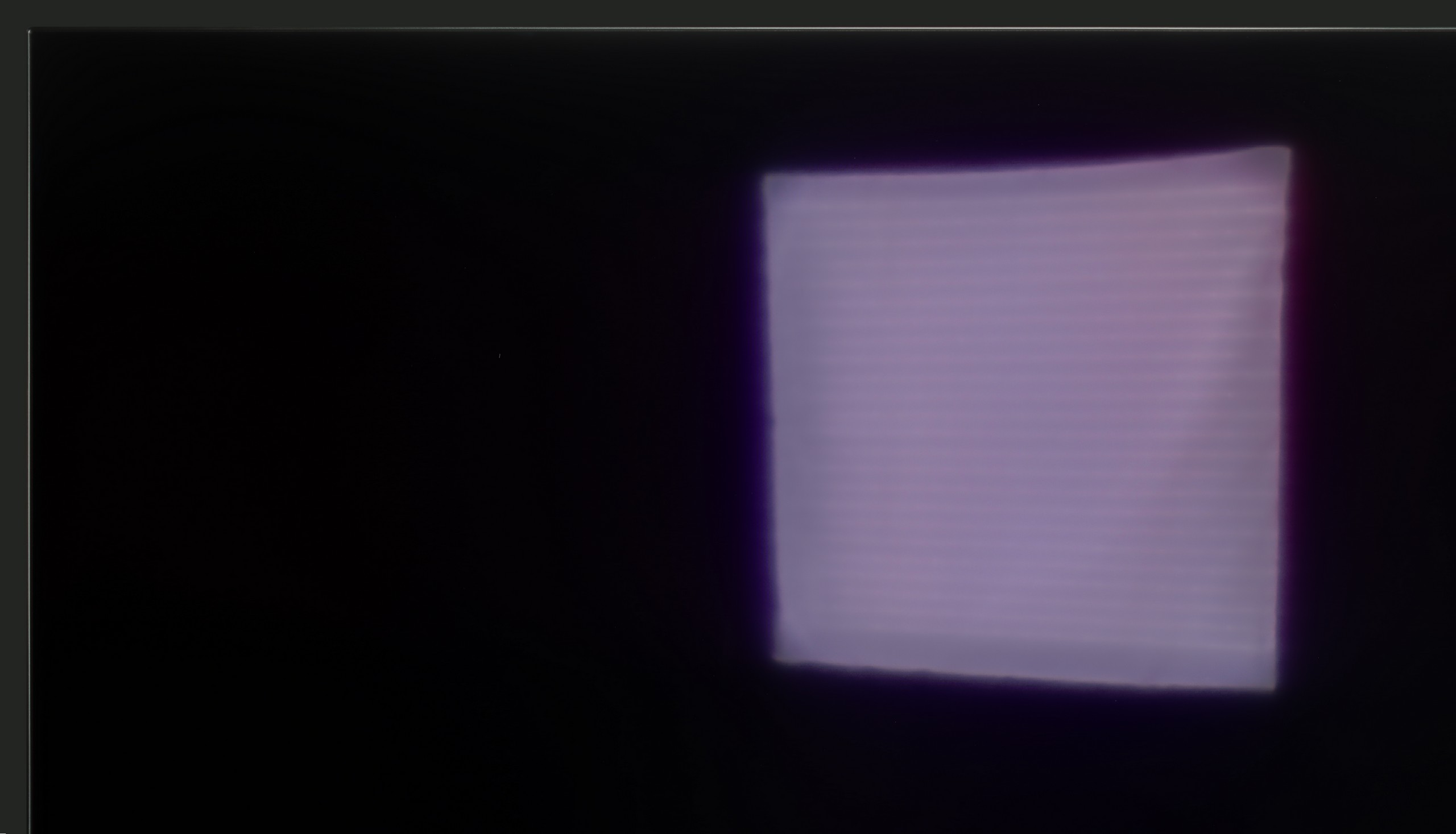



Matrix brightness
Average luminance SDR
Philips OLED770: 249 cd/m2
LG OLED B5: 279 cd/m2
The LG B5 is a television that feels best after dark. But when the sun comes in, it becomes a bit of a challenge. The brightness of this model is rather average, and the anti-reflective layer… also average. There are no special coatings here that deal well with reflections or very bright daylight. So if you're planning to place this television opposite a large, uncovered window – it may simply be hard to see anything.
Fortunately, there is something worth praising: the glossy WOLED panel maintains good colour saturation. Even in difficult conditions, the image doesn't fade or become "washed out," as can happen with some television models. In general, it's watchable, but if you're looking for a television specifically "for a bright lounge room," the B5 shouldn't be your first choice.
OLED770 is not one of the brightest TVs, so it's hard to recommend it for very sun-filled living rooms. In a bright room, its limitations quickly become apparent – the screen catches reflections and behaves more like a lightly dimmed mirror. Glare reduction is average, and in direct light, the screen performs poorly. Fortunately, the panel's coating does not distort colours, so even during the day, the hues remain natural, and the blacks do not dramatically lose their depth. Nevertheless, it’s hard to say that the OLED770 is a TV designed for bright spaces – it will definitely find a better home in a dimly lit living room or in a bedroom, where its strengths can truly shine.
Details about the matrix
Subpixel Structure:

Panel uniformity and thermal imaging:


TV features
7.9/10
5.5/10
- HDMI inputs0 x HDMI 2.0, 4 x HDMI 2.1 48Gbps0 x HDMI 2.0, 4 x HDMI 2.1 48Gbps
- OutputsToslink (Optical audio), eARC (HDMI), ARC (HDMI)Toslink (Optical audio), eARC (HDMI), ARC (HDMI), Mini-Jack (Headphones)
- Network InterfacesWi-Fi 2.4GHz, Wi-Fi 5GHz, Ethernet (LAN) 100MbpsWi-Fi 2.4GHz, Wi-Fi 5GHz, Ethernet (LAN) 100Mbps
- TV receptionDVB-T, DVB-T2, DVB-S, DVB-S2, DVB-CDVB-T, DVB-T2, DVB-S, DVB-S2, DVB-C
Classic features:
- Recording to USB (terrestrial TV)
- Recording programming
- Picture in Picture (PiP)
- RF remote control (no need to aim at the screen)
- Backlit remote control
- Teletext
- Audio only mode
- Bluetooth headphones support
- Simultaneous Bluetooth headphones & TV audio
Smart features:
- AirPlay
- Screen mirroring (Windows Miracast)
- Voice search
- Voice search in native language
- Ability to connect a keyboard and mouse
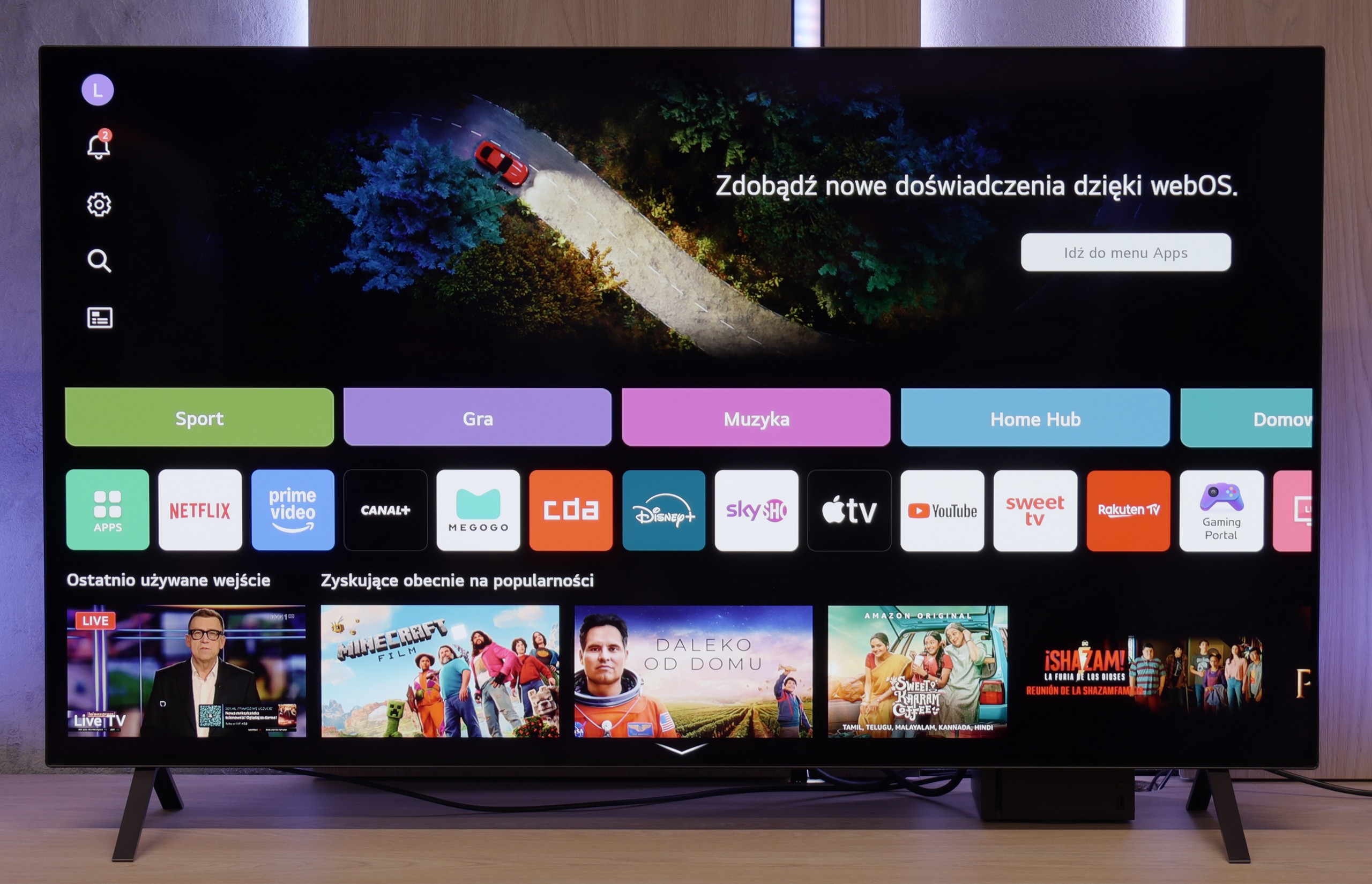
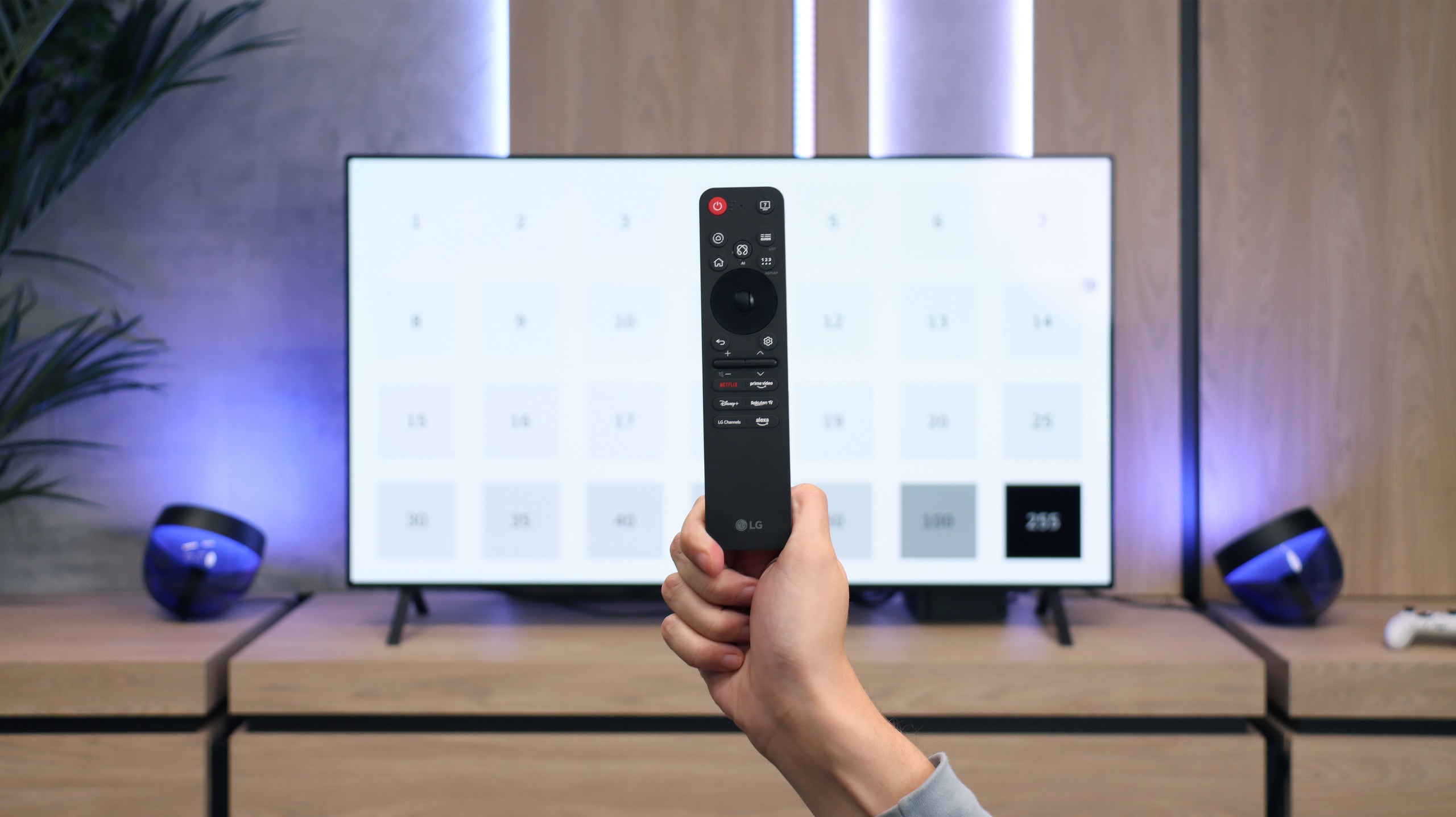
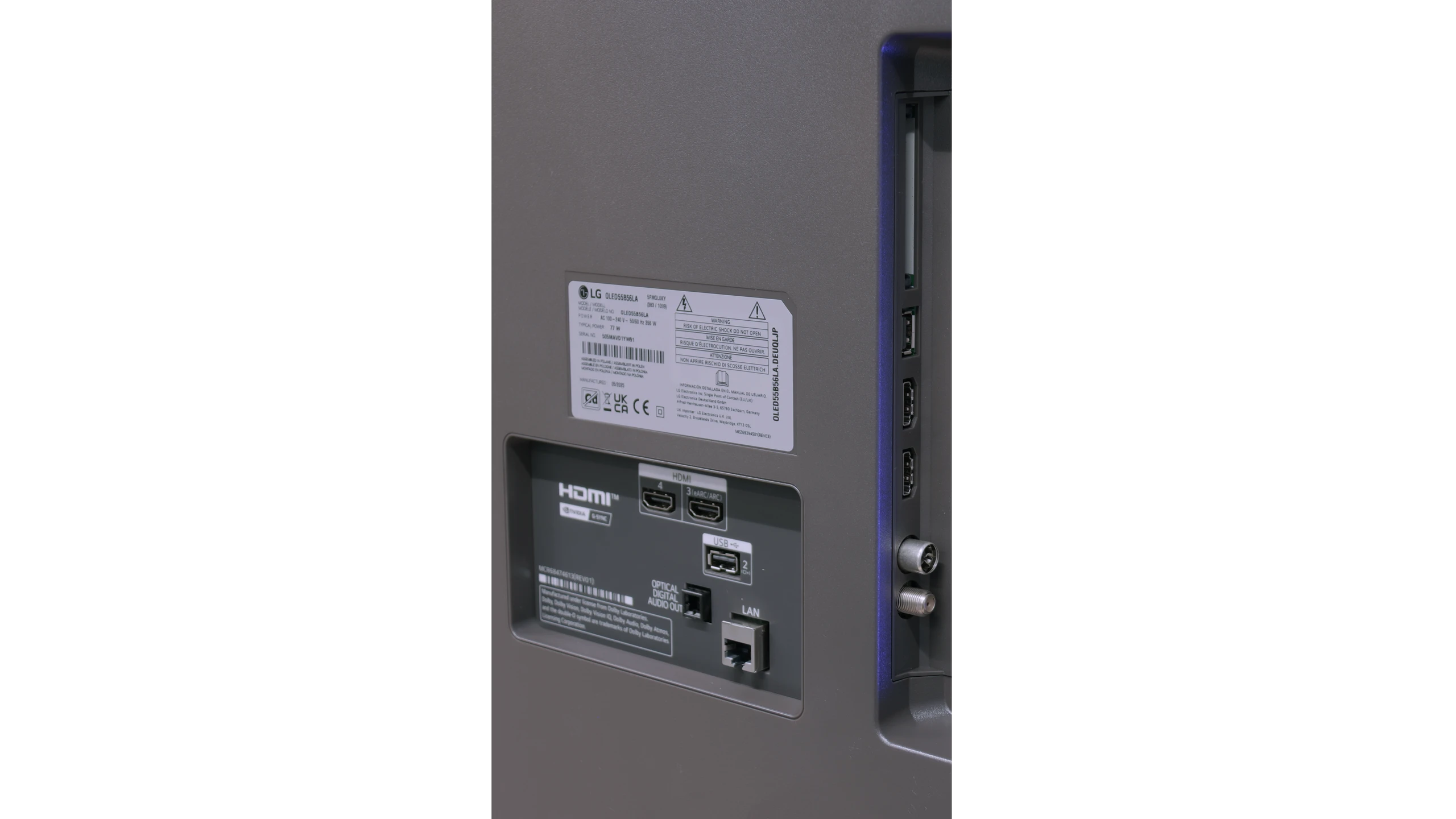




Functional Features
Even though the LG B5 is modern equipment, it hasn’t forgotten those who simply want to... watch television. No apps, no accounts, no logging in anywhere. We have built-in DVB-T2 tuners and the ability to record onto USB, with a clear and fast EPG guide. Is that not enough? There’s even a working teletext – for many, surely a relic, for others, a daily occurrence. A plus is also the option to turn off the picture and just keep the sound, which works great for listening to music. And if you want to watch quietly – you can easily pair Bluetooth headphones, without wrestling with settings and without delays. Everything works as it should.
SMART TV: webOS
The biggest distinguishing feature of the webOS system – still! – remains the way you control it. The Magic remote, which we get with the LG B5 (in our version B56 – the one without the numeric keypad), works like a magic wand. We point, click, select. And it simply... works. Intuitively, quickly, and without unnecessary clicking left and right. Added to this is the AI voice assistant – quite efficient. You can summon it directly from the remote and use your voice to search for content, change settings or switch sources. WebOS may not be the most "modern" system on the market, and built-in ads can be annoying, but when it comes to ease of use – especially with the Magic remote – it still stays one step ahead of the competition.
Functional Features
Let's start with the basics, which are the classic functions of a television. The Philips OLED770 doesn’t turn the table here; we have a standard EPG interface, the ability to connect devices via Bluetooth, and a few simple configuration options including teletext. Interestingly, there is a jack connection, which is becoming quite rare these days. However, those with older receivers or wired headphones will appreciate it. The remote creates a good impression – it’s ergonomic and has a backlit numeric keypad – but there’s also a sense of a step back here. It works via infrared, so you have to aim it at the television, and frankly, by 2025 we would expect full wireless support. The exception is voice commands, which use Bluetooth, but even here there’s no reason for euphoria.
SmartTV Features – TitanOS
Speaking of voice, let’s move on to the Smart TV system, which is an element that largely defines the daily comfort of using a television today. And here the OLED770 clearly lags behind the competition. TitanOS operates quickly enough that it's not a disaster, but daily use can be frustrating due to minor bugs and shortcomings. Theoretically, we get support for AirPlay, but on the other hand, screen mirroring just didn’t work at all in practice. Voice search? Yes, but only through Amazon Alexa and without support for the Polish language. In other words, the features are there, but when we try to use them, we find that their practicality is severely limited and nearly useless. And it’s this Smart TV aspect that becomes the greatest hindrance of the OLED770. The image can be astonishing, gaming is excellent, and Ambilight creates a unique atmosphere – but when we transition to daily use of apps and services, we feel a sense of dissatisfaction.
Ambilight – Philips OLED770
Although in terms of smart functionality, the Philips OLED770 is rather average, it has something in store that its competitors honestly envy. We’re talking about the three-sided Ambilight system, which has been a hallmark of this brand’s televisions for years. The LED lights positioned at the back of the housing dynamically illuminate the wall in colours matched to whatever is happening on the screen at that moment. The effect is simple but very suggestive – the image seems to extend beyond the boundaries of the television, giving us the impression that the screen has suddenly grown by extra inches. During a movie screening, it can create atmosphere, in games it enhances immersion, and during regular TV viewing, it simply pleases the eye. It’s this addition that makes it so that despite the limitations of TitanOS, the OLED770 has something that can attract attention and give it character.
Playing files from USB
8.6/10
8.5/10
Supported photo formats:
Maximum photo resolution:
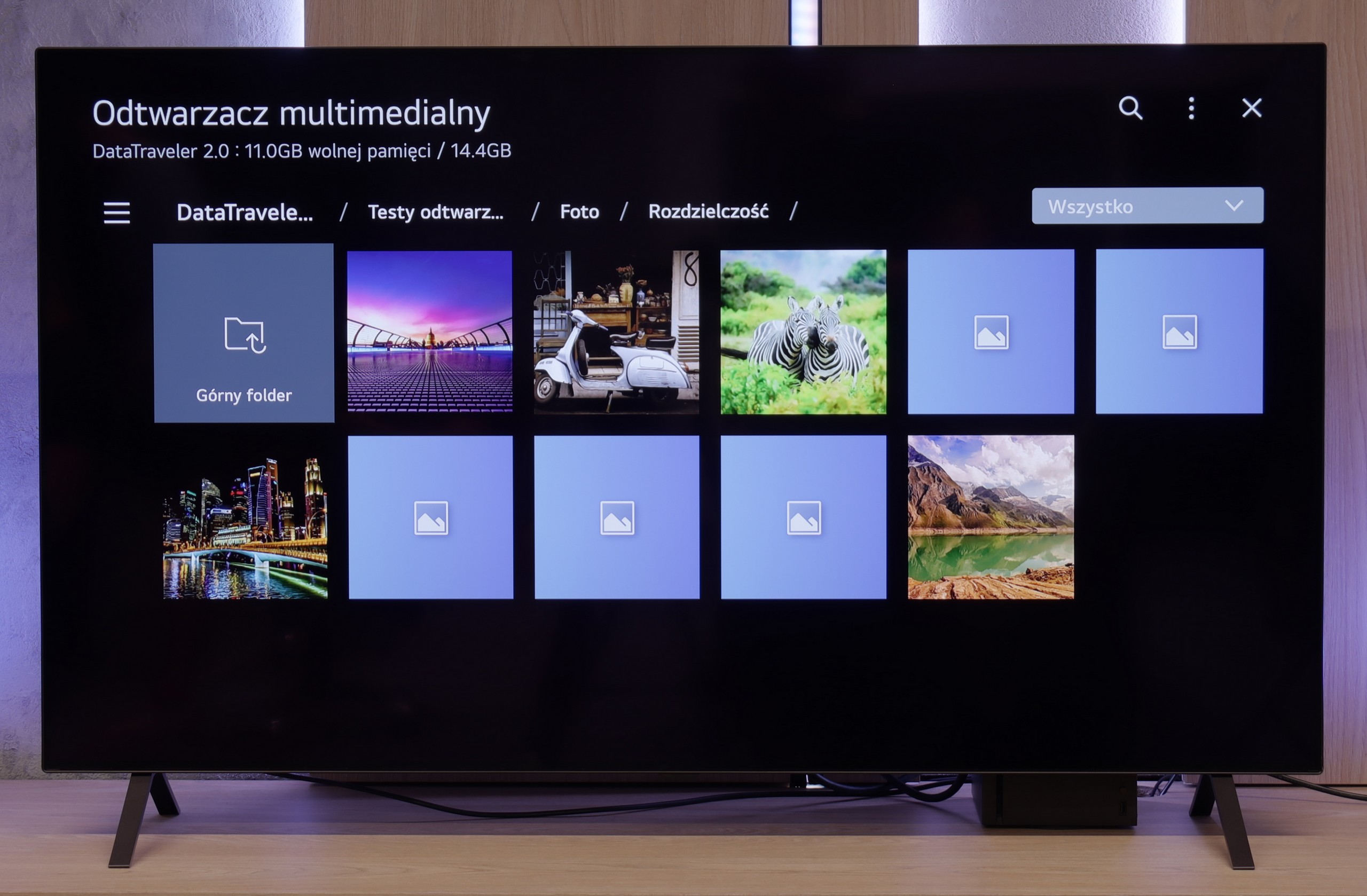

LG B5 handles USB files as it should. Most popular formats work seamlessly, and subtitles – even with Polish characters – are displayed correctly. You can comfortably play a movie from a USB drive or have a weekend slideshow of your holiday photos without worrying that something will go wrong. However, there was a surprise with files in HEIC format – that is, photos saved by Apple devices. While the LG C5 had no issues with them, the B5 stubbornly refused to cooperate and was unable to display them. A little hiccup that probably won’t affect everyone, but it’s worth knowing about.
The built-in media player in the Philips OLED770 works quite well, especially when it comes to subtitles – virtually every format we threw at it was handled correctly, which will certainly please those watching films from their own library. However, there are certain reservations regarding photo support. Not all resolutions are recognised, which may surprise users accustomed to viewing photographs from traditional cameras or older memory cards. Apart from that, everything works correctly – it’s just worth ensuring that the TV can handle the files that we actually want to play on it.
Apps
9.1/10
6.7/10














































Sound
7/10
7/10
- Maximum volume-80dB
- Dolby Digital Plus 7.1
- Dolby True HD 7.1
- Dolby Atmos in Dolby Digital Plus (JOC)
- Dolby Atmos in Dolby True HD
- DTS:X in DTS-HD MA
- DTS-HD Master Audio
We didn't expect miracles – after all, the LG B5 doesn't have an advanced audio system, and its built-in speakers look... well, just like the majority of flat-screen TVs. And yet – it actually sounded quite nice. The dialogues are clear, the sound isn't booming, and during a quieter viewing, we didn't immediately feel the need to plug in a soundbar. It's just a shame that this year LG decided to cut something that worked in the previous generation. We're of course talking about support for DTS formats, which we won't find in the B5. If you have movies encoded in that format – you'll need to rely on an external player.
When it comes to sound, the Philips OLED770 performs quite well, although you can't expect powerful bass. For regular TV viewing, streaming services or series, its capabilities are more than sufficient – dialogues are clear, and the overall tonal balance is at a decent level. However, when we want to feel a real punch in cinematic productions or games, it quickly becomes apparent that it lacks solid low-end response. In such a situation, a natural complement becomes an additional soundbar or audio system that will allow you to take advantage of the potential of the excellent picture.
On the plus side, versatility in handling formats must be noted. The OLED770 can manage practically all popular codecs, including Dolby Atmos, DTS:X, and Dolby TrueHD. Because of this, when connecting external audio equipment, you can expect a full sound experience, even if the built-in speakers in the TV don't make a spectacular impression.
Acoustic Measurements
No acoustic data
80dBC (Max)
75dBC


